#Marshall MOTIF review
Text
Marshall MOTIF ANC Wireless Earbuds Review
This is Motif A.N.C., the true wireless headphones from Marshall that amplify your audio while shutting down the noise around you with active noise cancellation. Carry the big stage in your pocket with 20 total hours of wireless playtime and the sturdy portable charging case. These wireless earbuds deliver big on their promise of thunderous sound in a neat package. Enjoy amplified audio in a sealed-fit design that is made for all-day listening. You should never have to go down in sound when you go down in size. Motif A.N.C. delivers the same Marshall sound in a design that is both sturdy and slim, with IPX5-rated earbuds and an IPX4-rated charging case that fits right there in your pocket.
👍🏻 Get your Marshall MOTIF ANC Wireless Earbuds here
UK
USA
DE
FR
ES
IT
Canada
#Marshall MOTIF ANC Wireless Earbuds#Marshall MOTIF#Marshall MOTIF review#Marshall MOTIF ANC Wireless Earbuds Review#best wireless earbuds#best wireless earphones#best wireless earphones 2022#best wireless earbuds 2022#best bluetooth earbuds#best bluetooth earphones#best bluetooth earphones 2022#best bluetooth earbuds 2022#wireless earphones#bluetooth earphones#earphones
1 note
·
View note
Text
E.T: A Comprehensive Review
At their best, both Spielberg and Lucas make idealized versions of the kinds of films they loved as kids, in the process furnishing this generation’s filmgoers with visual treats of unprecedented skill and sophistication. Despite the continual presence of the little Yoda-like creature, “E.T.” is not first and foremost an effects picture, but rather a charming “Twilight Zone”-like fable which reminds by turns of “The Wizard of Oz,” “Mary Poppins,” a benign switch on “King Kong” and a variation of Spielberg’s own “Close Encounters.”
Opening sequence actually comes off like a repeat of “Close Encounters”‘ final frames, as a sizeable spaceship takes off just before some earthly authorities are able to close in on it. One of its occupants gets left behind, however, and the viewer is instantly sympathetic with its plight in the threateningly different environment of a modern California subdivision.
E.T. is highly fortunate to be found by young Henry Thomas who, after some understandable initial fright, takes the ‘goblin’ in, first as a sort of pet and then as a friend he must guard against the more preying elements of human society. Over time, Thomas teaches E.T. how to talk and includes his older brother (Robert MacNaughton) and younger sister (Drew Barrymore) in on the secret, even as he manages to hide his discovery from his mother (Dee Wallace).
Ultimately, of course, the official representatives of society locate E.T., which seems to occasion a rapid decline in its health until it appears to die. When it revives, Thomas marshals his friends into a kids’ commando squad to spirit E.T. back to the spaceship which is on its way to a rescue rendezvous.
First element which had to work to insure film’s success was E.T. itself. As superlatively created by Carlo Rambaldi, the creature manages to project both a wondrous childlike quality and a sense of superior powers. Cutely awkward in its movements, the being has rubbery brown skin, an extendable neck and possesses eyes which dilate on cue. It even gets to play a drunk scene, perhaps a first for screen aliens. Assuredly not lost on those involved with the film are the opportunities for E.T.-related toys and dolls, which are enormous.
An amusing sidelight to the tale is that the action takes place in a suburban household almost identical to that in the Spielberg-produced “Poltergeist,” which leads to the thought that the two, distinctly different stories could be unfolding in neighboring homes simultaneously. In fact, many of the motifs in the early going are similar to those in “Poltergeist”–the middle-class family, the blonde dog, goldfish, people glaring into bright lights in awe and disbelief.
But “E.T.” will surely prove an embraceable film by the general public. Rarely has a picture so completely evinced a kid’s p.o.v. and shown the complicity of youngsters against adults. It’s been said that the only people who don’t like Disneyland are late adolescents who feel too hip to enjoy the pleasures of their earlier years, and the same will probably hold true for “E.T.”
As can be expected for Spielberg and the Industrial Light & Magic shop, the technical effects are state-of-the-art superb. Enough cannot be said for John Williams’ score, which stands as a model of film composing–although it is almost continually present it’s also practically unnoticeable, so well does it both complement and further the events onscreen.
As far as the performances go, the key was finding three kids who could respond with both innocence and gumption to the arrival of E.T. All fulfill the requirements, and Thomas is perfect in the lead, playing the childhood equivalent of Spielberg’s everyman heroes of his previous pics.
There are some unsatisfactory elements–slow spots occur during the middle stretch, the mild anti-establishment stance is getting to be a bit cliche and one never knows whether E.T.’s mortal illness is physical or psychological in nature, or both. But, as with “Close Encounters,” the truly lovely and moving ending more than makes up for everything. Chalk up another smash for Spielberg.
By Tom
6 notes
·
View notes
Text
Marshall Motif II ANC Review: Noise-Canceling Earbuds That Rock Your World
Marshall, synonymous with high-quality audio products, has recently stepped into the realm of active noise canceling (ANC) earbuds with the Marshall Motif II ANC. This review highlights every aspect of these earbuds, from design to performance, to give you a comprehensive understanding of what they have to offer.
The Marshall Motif II ANC showcases a distinctive design ethos that resonates with the brand’s legacy. The earbuds are crafted from premium materials, ensuring both sophisticated looks and durable build.
#tech news#technology#technology news#yourtechstory#technews#wireless earbuds#earbuds#Marshall Motif II ANC#Marshall Motif
0 notes
Text
Star Wars: The High Republic Informal Review
These are my initial thoughts and minutely biased opinion/review of the High Republic.
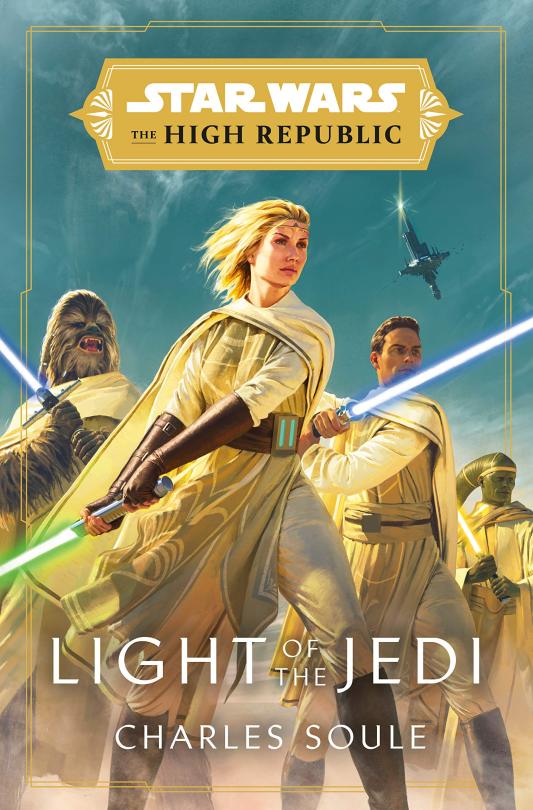
My basis is primarily founded on the first two issues of the High Republic comic book – written by Cavan Scott – along with a secondary basis, from a secondhand account of the book Light of the Jedi, written by Charles Soule. It is a secondary account because I don’t read books; I am not a book man. My friend loves to read books and he graciously gets on Discord with me basically every day and together we dissect and discern what’s going on in this new period of the galaxy.
This evaluation will mainly concentrate on the book portion and while not all encompassing, will give you a significant gist of how I’m feeling about High Republic. Also, there will be SPOILERS – you have been warned.
Overall, the book seems to have a strong first third, gets into a lull in the second third, and somewhat recovers in the last third but, arguably not as strong as that first third. The strengths of the book are definitely world building, the focus on Starlight Beacon, and finally, the introduction to all the new (old) Jedi; the Jedi are the best thing about the book.
Plot wise, the book centers on and around Starlight Beacon with hyperspace being the driving force of the conflict.

Starlight Beacon is akin to an amalgam of air traffic control, a mutli-cultural embassy, a Jedi Temple, and a bazaar. At this point, it housed the largest number of Jedi outside of Coruscant and used signals to guide travelers during their interplanetary journeys. It was made in response to the Great Disaster – a hyperspace tragedy that caused starships all across the galaxy to be abruptly launched out of hyperspace leading to several moons in the Trymant system, including Korbatal, to be destroyed. Beacon exists to better calibrate for, identity, and curtail these new anomalies as astromech droids are a rarity in this period of time.

Around the same time, a marauder group – called the Nihil – have found a way to board and raid ships while they are in hyperspace using hyperspace channels termed Paths. Through the use of devices - called Path Engines - Nihil ships are to make short-burst hyperspace jumps, allowing them to appear and disappear in a flash during battle. Their raids have led to deaths, including that of Jedi Jora Malli - a Togruta Jedi Master that sees the Force as a force – always in competition with itself. She was also very close friends with Sskeer; a Trandoshan Jedi Master that lost an am during the raids.

In accordance with that last point, hyperspace will be somewhat of the crux contention to fans (and really science fiction enthusiast in general) as this is not how hyperspace has generally been established to work in Star Wars yet, is the lynch pin in how conflicts happen. This even follies with the newly established way hyperspace works in The Last Jedi and The Rise of Skywalker but, I digress…

I knew there were going to be some major plot holes in this super prequel series but, my best hope was that they wouldn’t be too gaping. Just knowing that this application exists, changes many aspects of space travel and what characters going forward should know about it.
Canon mechanics aside, Charles Soule makes it clear why was given this duty; he has blatant skill for writing not only characters but, also taking the extra steps of having the individualized power of the character be an extension of them. He did this very well during his run in Uncanny Inhumans and he’s not disappointing here either (he’s had plenty of practice in the Star Wars realm already with books like Star Wars, Poe Dameron, and The Rise of Kylo Ren).
There are a multitude of Jedi brought in, which complements the time period and era of it being the High Republic but, the real asset of the book is Soule taking the needed time to give the reader a look at how each Jedi interprets the Force in their own way. Moreover, the pairings of different Jedi serve as accompaniments to each other in very noteworthy ways.

Jedi Master Loden Greatstorm, sees the Force as an ocean.

His Padawan, Bell Zettifar sees it as a flame – sometimes a raging inferno, sometimes glinting ember. (This is very fascination as usual flames are a motif associated with the Sith yet, here is Bell - a shining example of a Jedi - interpreting fire in a positive light. I also like how view of the Force allowed him to synch with his charhound, Ember).
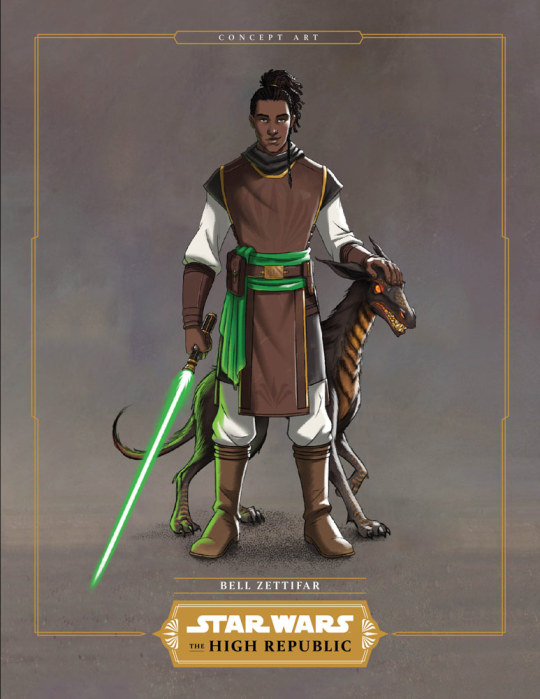
Wookie Padawan Burryaga Agaburry, perceives it has a tree attached to a leaf of equal size.
Vernestra Rwoh, the one of the youngest Jedi Knight in the order, sees it as a river.
Reath Silas, see it as a spider web – strong in some spots, weak in others.

Elzar Mann, views it as an endless, bottomless sea which was impossible to be used up, not matter for what purpose or however many times it was called upon. (I’m curious to see if there will be a differentiation between how Mann sees the force when compared to Greatstorm; an ocean is deeper than that of a sea.)

Finally, Jedi Master Avar Kriss, hears the Force as a symphony – moreover, she can connect with minds of other Jedi and is able see how other see how they see the Force.

Hot take but, the character of Kriss feels like a Kathleen Kennedy character as Kennedy been prone to interject White, third wave feminism (if you’re not intersectional then you’re not a “feminist” to me) into Star Wars. One of her signatures is to take a White human female and make her the either the main character or a key figure in the narrative. Avar Kriss, a White blonde-haired human woman, is literally depicted as “the brightest, most noble example of Jedi-hood” so, I’m keeping a keen eye on her – doesn’t help that she just got assigned Marshall to Starlight Beacon but, if it’s any consolation (more like mitigation), she was the SECOND pick as the first died.
Ultimately, if you are able to get the major hurdle that is hyperspace Paths, this is a competent and enjoyable start.
Soule even goes as far to add some interesting and even practical – yet lore breaking – devices in this age: he’s made a new (old) space ship called “Vectors” that are powered/steered by Force sensitive people with the lightsaber being the key to active it (even cooler, the hub takes the color of the lightsaber that activates it).

That’s a great idea and makes sense within the universe as whole yet, collapses on itself when you remember what time period, we’re in – the past, so why was this not built upon in the future?
It definitely feels like the books are 85% of the story while the comics (more on them in a later post) are – at their prime peak – a mere “intrinsic 15%”.
The best part for me has been the characters; hopefully, the plot will come along to accent them justly.
Arguably though, the best characters – that of Loden and Bell – should be depicted in the comics based on their gravitating dynamics and instant attachment with readers.

#star wars#the high republic#high republic#charles soule#light of the jedi#starlight beacon#loden greatstorm#bell zettifar#burryaga agaburry#vernestra rwoh#vern#reath silas#elzar mann#avar kriss#jora malli#sskeer#hyperspace#nihil#the path#vectors#kathleen kennedy#uncanny inhumans#the rise of kylo ren#poe dameron#the last jedi#rise of skywalker#cavan scott#white feminism#intersectional feminism
45 notes
·
View notes
Photo

Arild Andersen + Vassilis Tsabropoulos +
John Marshall — The Triangle. 2004 ; ECM 1752.
~
[ Album Review | All About Jazz ]
What a difference four years and touring time can make. The Triangle, the follow-up to 2000's sublime trio recording Achirana, shows a group that has grown in leaps and bounds, becoming something more, something larger.
Clearly Vassillis Tsaboropoulos, an established classical pianist whose first recording of improvised music was Achirana, has evolved. While the thrust of the trio remains in chamber jazz, his playing is more extroverted. "Straight" and the 5/4 piece "Saturday" demonstrate a new-found brightness, and expressionist approach; a far cry from his earlier, more inward-looking work. And bassist Arild Andersen and drummer John Marshall seem perfectly happy to join Tsaboropoulos in this more vivid space. Andersen's "Lines" revolves around a rapid-fire theme that settles into the most swinging interplay of the programme, with Andersen walking hard and Marshall's listening skills on high alert, following Tsaboropoulos' rhythmic twists and turns with remarkable ease.
That's not to say the trio doesn't visit more spacious ballad territory; but even on tender ballads like Tsaboropoulos' "Cinderella Song" and "Simple Thoughts" there is a rich vibrancy, a stronger sense of urgency. As auspicious a début as Achirana was, and it was arguably one of the best trio recordings of 2000, it was somehow more tentative, and far more abstract. There is a refreshing directness about The Triangle that highlights a trio that has truly come into its own in the intervening years.
Much of this has to do with Tsaboropoulos' growth as an improvising player; Andersen and Marshall both have long histories of working in a variety of contexts, so their ability to meld to any stylistic change comes as no surprise. Tsaboropoulos still demonstrates a penchant for playing over the bar lines, creating long, snaking themes that develop over time. And, while his melodies can be complex, they are always lyrical; there is nothing abstruse in his ideas.
Tsaboropoulos has also grown as a writer. The simple repeating motifs of Achirana have been replaced with deeper harmonic ideas that unfold gradually and, rather than being bare sketches, provide the trio with forms that are more substantial. The result is a recording that, while it clearly is rooted in the overall musical concept of the first, shows remarkable evolution. While growth is a characteristic that all good ensembles demonstrate, it is not often that it is this overt, this palpable.
The Triangle's title refers to the fact that Andersen in Norway, Marshall in England, and Tsaboropoulos in Greece form a European triangle of musicians. But even more, it refers to a group where each point is as important as the others. And clearly this triangle is an equilateral one, where every side is equal, every player as important as the next. Demonstrating that the growth of one player can spur the entire ensemble to greater heights, The Triangle will surely follow Achirana as one of the finest piano trio recordings of this year.
#jazz#jazz piano#piano trio#jazz trio#Arild Andersen#Vassilis Tsabropoulos#john marshall#ecm#2004#2000s#2000s jazz#rainbow studio#review#all about jazz
1 note
·
View note
Text
Broadchurch Season 1 Review
After surfing Netflix for some time i settled down to watch Broadchurch once and for all. i hadn’t heard anything much prior to it as i don’t live in the UK and it was honestly just out of curiousity towards David Tennant that i ended up watching it (that and i somewhat missed a good murder mystery).
General comments:
I really, really, really enjoyed it. After the first (introductory) episode, we were really hooked into it. (Contextual info: i watch most TV with my brother and my aunt. i find it more fun that way.)
We binged the next seven episodes, which is really saying a lot in itself because generally, we don’t binge watch.
The story plays out like something from a Miss Marple mystery. However, the show has an element of modern cynicism. They tackle the bare, bleak facts very well, and the plot doesn’t shied away from tough themes like broken relationships, pedophilia or guilt and depression. All the individual stories are analysed in great detail, going into the nuances of human relationships and that’s something I really enjoy. I won’t go into too much detail but one of my favourite side-plots was Jack Marshall’s, because it was so beautifully complex. The contrast between the personal and intimate relationships against the cruel reality of the situation and the tragedy that followed in his life is a moving but also thought-provoking story. Even when he (spoiler!) takes his own life, his choice in throwing himself off that cliff is strangely cinematic. And it brings a sense of deja vu, echoing to the beginning of the series when Danny’s body was first found on the beach. It was a very sobering, cyclical moment and you can see the characters, especially Hardy and Miller, trying to strive past this (both emotional and mental) setback and move forward.
Olivia Colman’s performance was definitely one of the highlights, especially drawing towards the middle and final episodes. She managed to give a beautifully complex yet subtle performance: conveying the concern she held for her son Tom; the drive for her work to see justice done coupled with regret for the late nights and time taken away from her family. Opposite DI Alec Hardy, Ellie brings a beautifully relatable and human perspective of things. The chemistry between the two is undeniable, and although i don’t expect romantic feelings to evolve (but this doesn’t mean i don’t ship them SO much), i expect that a deep, unique friendship will be the product by the end of the seasons.
Imagery motifs: the waves, the cliffs. These were beautifully done, and really emphasize the uncertain and mysterious~ atmosphere.
I think i found an ABSOLUTE gem and I can’t wait to see how the series goes on.

REALLY.
2 notes
·
View notes
Text
Marshall McLuhan’s social criticism
“Blondie and her children own America, control American business and entertainment, run hog-wild in spreading materialism into education and politics,” he insisted. The traditional order in which man upholds a rational authority and is sustained by the emotional support of his wife had been overturned. The only cure was for Dagwood to reclaim “the detached use of autonomous reason for the critical appraisal of life”--in other words, to invoke the combined spirits of St. Thomas Aquinas and F.R. Leavis--and to engage in “healthy and fructifying work,” that is, to give Mr. Dithers his notice and sign up in the wheelwright’s shop that Leavis so admired in Culture and Environment.
McLuhan was happy to see the article exposed to a relatively large readership (half a million circulation), but he was worried that it appeared in a Roman Catholic magazine. He wanted to prove himself in the larger world of scholarship before making a public appearance under such auspices. To become identified as a Catholic intellectual at the start of his career seemed unwise. Far better to act, like his opposite number, the dedicated Communist, as a sort of mole in the academic world, swaying minds that might be repulsed if one’s affiliations were made obvious.
McLuhan definitely wanted to sway minds with this theme. He had visions of expanding “Dagwood’s America” into a book, which he tentatively titled Sixty Million Mama’s Boys. He thought such a book might prove a hit as a piece of “impudent” pop sociology along the lines of Generation of Vipers, Philip Wylie’s 1942 best-selling attack on “momism”--though of course McLuhan’s book would be far more profound than Wylie’s.
The implicit antifeminist message of this book (which was never published) and of the Dagwood theme in general consorted, in those years, with McLuhan’s persistent suspicion of homosexuals, overt and closeted. In 1949, Felix Giovanelli wrote him about Gershon Legman, a mutual acquaintance who was an authority on Freud. Legman, Giovanelli reported, was as wary of homosexuals as McLuhan was and held the same belief that they lurked everywhere in places of cultural influence. Giovanelli implied that Legman was another ally in the struggle to alert the public to this unhappy situation, which was first hinted at in a 1931 book McLuhan had studied, The Diabolical Principle, by the painter and writer Wyndham Lewis. In it, Lewis suggested that the “homosexual cult” was a direct result of the feminist revolt.
In McLuhan’s eyes, Dagwood, the mama’s boy, and the homosexual were closely related figures. Grand sociological theories aside, he had been horrified by the “homosexual cult” since his Cambridge years and retained throughout his life the repugnance of a strait-laced Methodist child for homosexual activity. During his later years he was very careful to keep his opinion to himself, but throughout the 1940s his distaste was transmuted into a significant, if discreet, motif of his social criticism. He feared that male homosexuality was rampant in the age, the result of Blondie’s emasculating Dagwood in front of Cokie and Alexander, their children. Such homosexuality was probably the chief threat to contemporary morality.
McLuhan tried to publish his social criticism in general-interest magazines. During the war, he submitted an article entitled “Is Postwar Polygamy Inevitable?” to Esquire magazine. His argument was that the increasing prevalence of divorce, sexual promiscuity, adoption of illegitimate children, and artificial insemination had already removed any aura of sanctity from monogamy and the bearing of children by monogamous parents. In addition, the dynamics of industrial and commercial life, reducing both men and women to the status of wage-slaves and consumers, were making the traditional monogamous family an economic luxury. Men could no longer support families in proud independence. McLuhan’s prediction was that women, who were “constitutionally docile, uncritical and routine-loving,” would take over the running of commerce, industry, and government, collectively supporting a class of male loafers and warriors, in the manner of certain primitive tribes.
The argument is not entirely clear--it was certainly impenetrable to the editors of Esquire, who promptly rejected the article. It does reveal, however, an uncanny anticipation of our present era of even greater divorce and promiscuity, massive participation of women in the work force, single-parent families, surrogate motherhood, universal daycare, and other post-monogamy phenomena....
McLuhan’s greatest successes were the articles that combined the culture and environment strain of social criticism with the literary perspective of his trivium studies. The first of these was “Edgar Poe’s Tradition,” published in the Sewanee Review in 1944. In this essay, McLuhan placed Poe in the tradition of rhetoric, of Cicero and the Renaissance humanists, which he believed took root in the American South. The result of that tradition, according to McLuhan, was Poe’s naturally cosmopolitan and aristocratic outlook, his high standards of literature, and his ideal of a society informed and led by men of wide learning, political savvy, and eloquence.
He expanded this theme in a series of essays for the Sewanee Review over the next few years. In “The Southern Quality” he elaborated on the southern tradition, associating it not only with Renaissance humanism and the study of rhetoric but with a way of life that was based on agriculture, communal living, and aristocratic values. Opposed to this was the tradition of New England, associated wth dialectics--utilitarian logic--and a way of life that was commercial and industrial, based on aggressive individualism. The southern tradition obviously encompassed many of the qualities he would later describe as “acoustic” and the northern tradition qualities he would describe as “visual,” although he was not yet thinking in those terms.
As always in his writings, there was no doubt which tradition he favoured. McLuhan’s admiration for the American South was a product not only of living with a wife who had an inextinguishable east Texas accent but of a genuine regard for the civilization that Jefferson had attempted to nurture. McLuhan was impressed by Jefferson, the aristocrat who was a scholar and a gentleman. Wholly free of any snobbery himself, he found immensely attractive anyone who was courtly, respectful of tradition, self-possessed, and also deeply responsible.
In “Footprints in the Sands of Crime,” McLuhan cited Edgar Allan Poe’s Dupin, Sherlock Holmes, Lord Peter Wimsey, and other notable sleuths as beloning to the gentlemanly and erudite tradition of Cicero and the Renaissance rhetoricians and humanists. The direct lineage of the sleuth was through aristocratic dandies such as Byron and Baudelaire, with a bit of the man-hunting noble savage of James Fenimore Cooper thrown into the gene pool. The significance of the sleuth was his utter contrast, given such a lineage, wth the commercial society around him and with its paid functionaries, the police. While McLuhan had no admiration for either the style of the substance of detective fiction, he maintained an ongoing fascination for the sleuth figure and once allowed himself to be photographed in a Sherlock Holmes outfit. He saw his own work with the media as an example of sleuthing, the relentless search for the telltale clue.
2 notes
·
View notes
Text
Marshall Motif ANC Review: Stylish fully wireless headphones with pleasant sound
Marshall Motif ANC Review: Stylish fully wireless headphones with pleasant sound
In today’s review, we’ll take a look at another model from Marshall, from which we’ve reviewed the Minor III wireless headphones or the popular Major IV headphone model in the past. Today we have another model, which bears the name Motif ANC and is trying to break into the group of fully wireless headphones with ANC with a price tag of up to 5 thousand crowns. Will he make…

View On WordPress
0 notes
Text
Rabbot Reviews: Far Cry 5
Great taste, empty calories.

Far Cry 5 is the latest game in quite the lineage of a series known, as you might surmise, as Far Cry. Game number 6, actually, dependent on how canon you feel Primal was. FC as it stands now, though, is a bit of a… how to put it? A long call? A distant yell? An outlying wail? A remote shout? No, a far cry from the original two games, before Ubisoft bought the franchise.
(Yeah, that’s the phrase. Glad I thought of it, though I don’t know where I got it.)
((Incidentally, Remote Shout is the name of my new indie punk garage band. Album drops: never, because this is a joke.))
Starting after Far Cry 3, Ubisoft has been telling their dev teams to make lightning strike twice. Thus, each game hereafter has been an excited waiting game of seeing how they’ll try and ultimately fail to match the demented, yet incredibly charismatic villain that was Vaas.
And 5 feels like this illogical conclusion of just that. Because you have not one, not two, but four scenery-eating, rompy villains. Less a refined, precise attempt at the concept, and more of a blunderbuss approach; hoping to tickle a little of everyone’s villain fancy.
That, I feel, is the perfect metaphor for the game in general.
Last call to avoid spoilers.
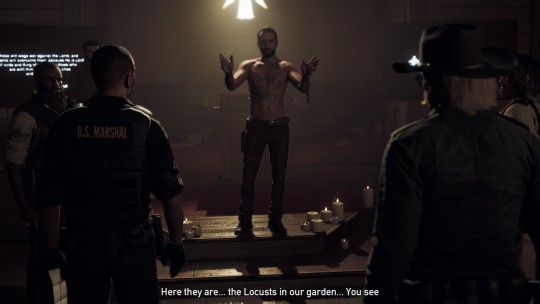
Speaking of fitting descriptions of the entire game, let’s start with the intro. Because I have mixed feelings about it, at best. There’s a lot it does right, and some things it simply gets wrong, in regards to the rest of the narrative as a whole.
The pacing and atmosphere are phenomenal. The very air feels heavy around you as you enter into the church, here to take the titular Joseph Seed away from his flock. The pressure of the stakes are established flawlessly, leaving a feeling of palpitation, and a true understanding of just how dangerous Joseph is. Surprised as I was, the game even managed to shock me a little.
In that respect, it’s fantastic.
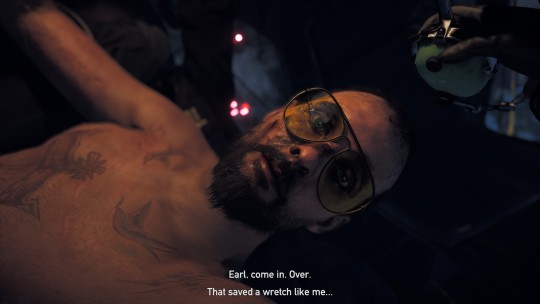
But then the game uses the cop crew you rolled in with as your motivation for the entire rest of the game, in the form of saving them from the Seed family, and oh god, it’s Fallout 4 all over again.
Just like the Bethesda example above, this aspect of the intro simply doesn’t work. And not just because it’s asking me to unconditionally care about cops.
This sequence of the narrative focuses on every other aspect of narrative setup except for the characters that you’re supposed to get invested in. You get but the most cursory taste of who they are as people. Such a small amount of time can mainly attach their personalities to a specific emotion.
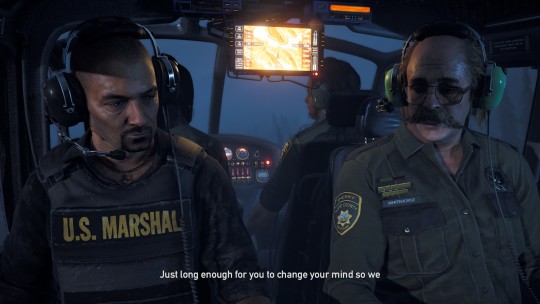
Whitehorse is the calm voice of reason. Marshall Burke is frustrated. Pratt is nervous. And Hudson is… there too, I guess. Look, I’ll be honest, I had to look up half these people’s names for this review. Which I’m sure is only a good sign.
With so little to go on, I found I simply didn’t care whenever a cultist bigwig dangled one of them in front of me on a string, expecting me to bat like a good little kitten. Instead, I yawned and wandered off to play with the packaging the toy had come in.
Like a mischievous little kitten.
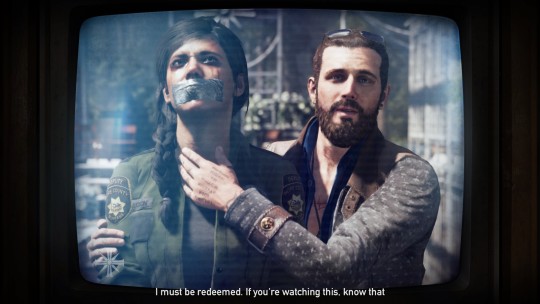
Which is such a shame, because there are so many other more interesting characters I actually did care about. And in the few scenes where the Seeds held them to ransom instead, the game suddenly had actual stakes.
Nick and Kim Rye were delightful every time they showed up. Virgil was so honestly sincere, I couldn’t help but like him; and his past, as it unfolded, was interesting to dive into. And Jerome was pretty much cool by default, and an excellent concept for a foil to the cultist bad guys, and everything they stood for.
But the story feels almost unconfident in its execution. Like the team is scared you’ll get bored. So the solution, write more story, or rather, several seemingly self-contained stories across the three separate regions.
With no overarching theme or plot threads besides “Joseph Seed probably gave the command for this at some point,” however, the connection feels loose at best. And this looseness makes the narrative feel all the weaker.
I’d much rather the story had been more focused and condensed. If they’d honed in on about one third as many characters, and if the villains felt a little less redundant, the overall narrative could’ve been much more refined and interesting.
Even the gameplay, while fun, has the same issue.
When traversing from place to place, you can’t drive for five minutes without a dozen random encounters passing you by, whether they travel by wheel or foot or paw. What should be a ten minute trek can sometimes take 30.
Again, it feels like the game is nervous. Like it’s worried that if I’m not firing a gun every two minutes, I’m losing interest. Look, I know this is the age of the internet, but my attention span hasn’t deteriorated that bad.
What were we talking about again?
But it’s sad though, as it detracts from what could be some very nice vistas and scenic routes. I can barely enjoy the quiet, introspective new addition of fishing without a randomly spawned cultist with an exaggerated country accent shouting “Fay-oond ‘eem!” and scaring away all the darn fish with a wild assault rifle volley.
Speaking of guns, let’s talk about politics. Something that could only ever be fun and only ever go over very well.

I don’t want to get too deep into this, as it’s been covered to death, and more eloquently than I’ll probably put it. For a better dive into the subject, I’d recommend watching Errant Signal’s “The Art of Saying Nothing.” To sum it up though, while at face value, FC5 might seem as though it’s about to lay down a scathing indictment of certain aspects of American culture, it really doesn’t.
Not for lack of bringing it up though.
The lady who owns Peaches the cougar, that is to say, the former owner of this sweet large kitten (no I’m not looking up the name this time; she’s not even a narrative footnote), is a prejudicial old woman who lives alone in the woods.
Immediately upon entering her domicile so I could acquire my new kitty and leave, she mentioned that my player character looked vaguely Italian, and made an off-color comment about not wanting her silver/jewels to go missing.
What is this, the turn of the century, last century?

At Hurk’s place, you can meet his dad, who wants to build a wall. What, no, not a wall down there. A wall in the north, to keep out those accursed Canadians and their liberal ideology.
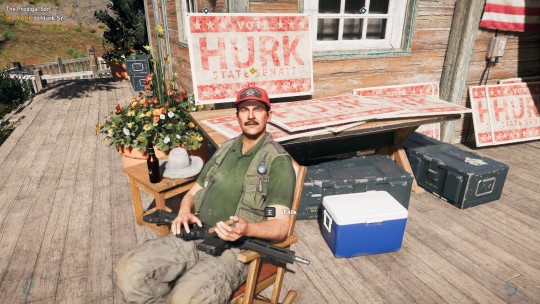
Addressing controversy by obfuscating the real world equivalent is cute, but it lacks the punch that makes it such that it’s proving some kind of point. Here, it’s npc’s that you’re expected to stay on good terms with, so that you can get more quests and goodies, like a new pet or ride.
(Shame you never get a new pet who is also your new ride, though.)
And why? Because they’re supposedly better than the cultists who only physically hurt and impede people different than themselves? What’s the takeaway here supposed to be, that it’s only physical extremism that’s bad and--oh god wait no, it’s Bioshock Infinite all over again.
Of course, we all know the real reason why. To offend as few people as possible. Because every offended party is a potential lost sale. Hence why despite clearly using Christian/Baptist imagery and motifs, no cultist ever actually mentions Jesus by name, and the peggy symbol only vaguely and technically resembles that of a cross.
I’ve bad news for you, though, Ubisoft; it’s too late. If you wanted to offend as few people as possible, it was already over the instant you let writers set it in a rural, dominantly Christian, dominantly white community, in America. Right wing talking heads were lining up to be officially offended the instance promos started showing bad guys toting guns, bibles, and the American flag.
Because despite bragging about having thick skin, when it comes down to it, they typically don’t.
At some point, you almost want to lean in uncomfortably close to the game’s face and tell it “Go on. Say what you really mean.” And it never does. Making it satire with no teeth, which isn’t actually satire, but parody. It’s a flag-waving, gun-toting parody of American culture. It’s an American beer commercial meets Saint’s Row. It’s a romanticized outdoorsy rural locale with tacky looking guns and gruesome murder set to made-up gospel and old rock hits.

Which doesn’t feel that far off from a Saint’s Row game, but it wildly conflicts with the tone Far Cry 5 very quickly establishes for itself. And it’s such a waste, because to use an on-theme colloquialism, “bless its little heart.”
It’s trying so hard, and there are some things I can’t help but enjoy about it.
There was a moment early on, when I was creeping through the bushes of a small neighborhood as slowly and quietly as I could. I had not but a bow and a pistol to my name. Cultists were stacking dead bodies while their speaker-mounted truck played their very own choir, singing about water washing away sin. As they were finishing up, they began to sing along.

It was as First Blood meets Jim Jones as the entire game felt, and it all just clicked. The gameplay and tone all lined up so perfectly and felt so right. Where did that go?
Luckily, the game is also pretty charming in various other inadvertent or otherwise unintentional ways.

Obviously it’s cute and wholesome that you can pet all the non-hostile animals. But it’s completely adorable how Peaches growls at you when you go where she can’t follow.
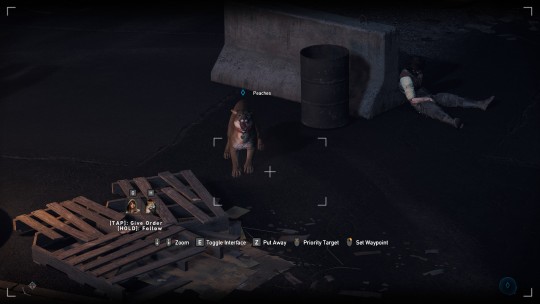
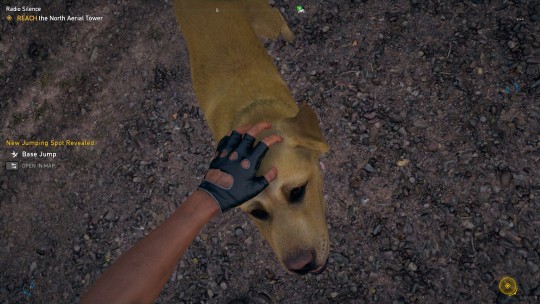


There’s also random npc’s you can recruit for the game’s buddy system, aside from the nine named specialty partners. At first, I seriously wondered how any of them could compare to Peaches, the oversized mewling kitten, or Grace, the cool as a cucumber sniper lady.
But then I found some lady named Evie, who looked like somebody’s mom, and I honestly found it hard to part with her. There was something so ernest and amusing about the idea of somebody’s mom who used to embarrass them at every PTA meeting or bake sale, now in an awkwardly-fitting militia vest yelling “Get some!” to every other cultist who dared cross our path.
The gameplay is also varied enough with timed races, and puzzling treasure hunting segments. The latter in particular, I really enjoyed. They had me doing everything navigating mazes of fire to hopping and swinging along successive grapple lines under a bridge, skirting river water along the way. It’s good, varied fun.

I also really appreciate the organic way in which story beats are unlocked, which is really saying something for a sandbox. Normally, there are specific missions that unlock the next cutscene that actually matters, and everything else feels like so much filler and padding.
Far Cry 5 had the genius idea that everything should contribute to an overall progress bar. This makes it that nothing feels like padding, as you’ll always be working toward the next story beat, even if you’re doing what feel like side quests.
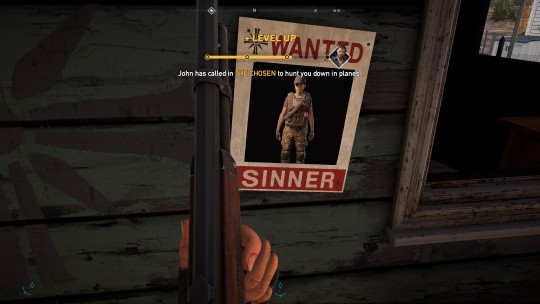
But it’s one step forth and one step back with you, isn’t it Far Cry 5?
Once you’ve unlocked the next story beat, you’ll be whisked away to the next cutscene to have one of the villains get in your face for the next five minutes, whether you were ready for that or not. It gets annoying after the second time, and downright numb the fifth or sixth.
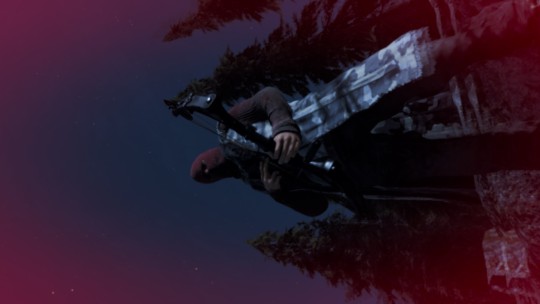
It’s also where the writing starts to fall apart some more.
You know that old James Bond trope where the bad guy has him right where they want him? But then because the villain is so contrived in how they want to handle him, he ends up getting away? Well that happens almost every time. It’s cheesy.
Also where some of the worst writing in the game comes into play.
Jacob Seed has a neat gimmick, I’ll admit. He’s all about classic conditioning, A Clockwork Orange style. Alright, interesting enough. And instead of escaping, you wake up, presumably days later, having finally escaped his mind control. It was a neat twist at first.
What’s incredibly stupid though is everyone points it out. Dutch, Eli, all characters who know about Jacob’s MO, and none of them think anything suspicious about it. Nope, just “Hey, now that I can finally get in contact with you after an entire week of you not responding, come back and get uncomfortably close to me and people I care about.”
Nobody thinks anything’s up with that? Even after it happens three or four times?? And not even my own character thinks to warn them that I’m being psychologically manipulated to kill them???
Oh. Look at that. The game made me kill Eli. How very unsurprising. What is that, something like four hours of build up to a twist anyone could see coming if they’ve ever seen a story?
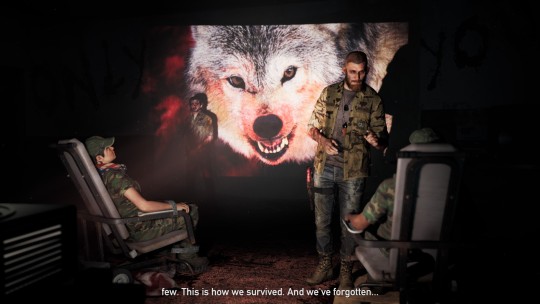
“Who cares, it’s fun, isn’t it?”
I mean, yes, sure. It’s very fun, in fact. Fewer things have been more satisfying than timing it just right to take down three baddies at once, with a sniper shot from Grace, a mauling from Peaches, and a throwing knife from myself.
And like I said before, the gameplay is just varied enough to not grow dull. But what should be a good game is held back by mediocre writing and a lack of commitment.
Weirder than any of it though is the troves of people lining up to say it doesn’t matter, because the game is fun. Listen, I can enjoy the gameplay for hours of mind-numbing fun, but still be able to pick apart everything wrong with the overall experience. There’s nothing really wrong with that. It doesn’t completely impede what enjoyment I, or anybody else, was able to get out of it.
I really don’t get this, though. This is no critique of the game itself, mind you, but it is at fault for bringing it up again, even if by accident. So it bears discussion.
Clean Prince was right when he said that Far Cry 5 brought up a lot of what’s wrong with modern gaming culture. Yet I can’t help but disagree with his reasoning behind this statement. Because he, like many, asked why any of it matters, so long as the game is fun.

Look.
Gamers clamored for years, demanding our hobby be taken seriously. Entire groups and brands like Extra Credits formed, to try and gain for games the same respect film and literature already had.
Nowadays, we have critics aplenty, like Super Bunny Hop, and the above-mentioned Errant Signal, who regularly dissect games with the same attention to detail movies, shows, and novels receive.
We did it. We’re here. We made it, right?
No.
People tear down bad writing in games, and suddenly it doesn’t matter. The game being fun is the only feature that matters, now that it’s convenient to dismiss anything that seemingly gets in the way of your enjoyment.
Even though it doesn’t.
If Far Cry 5 were a film, people would be trampling over each other to repeat the critics’ disregard of its milquetoast shotgun approach to writing, and lack of commitment to an actual point, despite advertising itself as any kind of satire.
It’s not like having an actual statement is foreign to Far Cry either. Far Cry 2 had a well implemented theme of deterioration in every aspect; your character’s health thanks to the malaria, the guns falling apart from being old, fire spreading wildly out of control.

It’s not even necessarily a Ubisoft problem either.
Far Cry 3 was all about the lengths you’d go to for the people you care about, and how growing and changing as a person ends up alienating you from them anyway. There was also an underlying theme about there being no real winners in a setting so deeply seeded with violence.
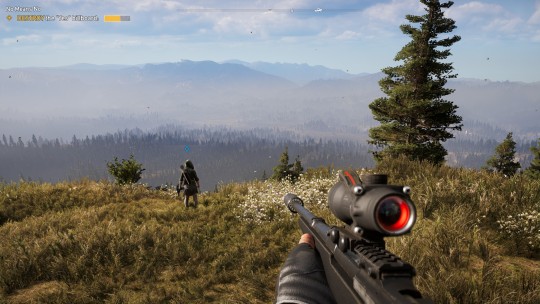
Ending sucks too. That’s not a good transition, but it’s as good of one as it deserves, to be frank.
It’s awful, but not because it’s unsatisfying and you don’t get to technically win. Not every game needs to end on a positive note, just because you work for it. Spec Ops: The Line had some of my favorite gut-punch endings in a game.
But the takeaway is just bad, for either ending.
Either you walk away from Joseph at the end, and Jacob’s conditioning kicks in again, and you kill everyone you just saved, or randomly and completely out of bumbling nowhere, several nuclear warheads go off around the tristate area. And everyone you just saved dies in irradiated fire anyway.
What’s the takeaway here? That we should just let dangerous people get away with violent uprisings, because hey, who knows, they may actually have been right all along?
The nuclear ending especially is just bad writing. It’s a twist out of left field meant to shock, and take you by surprise, but only because there’s nothing to indicate it’s going to happen. It’s trying, and failing, to ape the nuke scene from the first Modern Warfare game. But that scene was the dramatic release after an entire level’s worth of building tension regarding the bomb which was mentioned earlier. Of which said established tension, there’s simply none here.
Each region even caps off with you burning out the cult’s various bomb shelters. Only to find out, what? That you should’ve given up and let them kill and maim and steal all they like, so you could huddle down next to them in their bunkers? All because some uninformed zealot who doesn’t even sound like he’s actually looked at a bible lately made a lucky guess?
No thanks.

Instead of inspiring shock and awe, the ending feels random and nonsensical. Once again destroying any coherency the overall tone the game could’ve had. Is this supposed to be a fun, silly game to be enjoyed with a beer or a friend?

Or a serious and somber game where you face the deepest human fear of all: how people manage to justify overt acts of pure evil as “the right thing?”
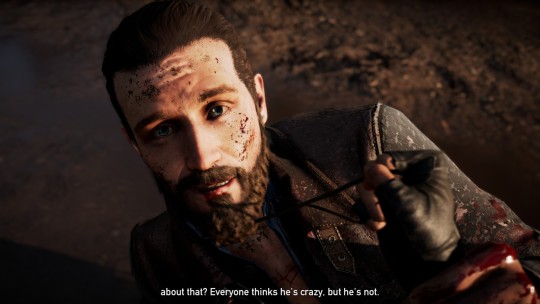
All in all, Far Cry 5 is like a cheap burger from a fast-food joint. The taste is fine and it’ll tide you over, but it’s probably not very good for you. And you can’t help but think about how much better it looks in the pictures on the menu.
25 notes
·
View notes
Video
youtube
Marshall MOTIF ANC Wireless Earbuds Review
1 note
·
View note
Text
Modern Jurisdiction Helping to Sustain Sexual Violence Against Native Women on Indian Country
How often do you think about American Indians? Only when you watch the Redskins play, only when you see the Chief Wahoo logo, or maybe only when you hear of natives fighting for water rights on their own reservation? If you answer, “not very often” you're not alone. The spotlight Native Americans receive in the media is very slim and practically non-existent. This lack of awareness of Native populations has let injustices continue to rage on in the dark. This post will shed light upon a large problem that plagues Indian Country and specifically targets Native Women.

Prior to colonization of North America, indigenous tribes possessed inherent characteristics of sovereignty and functioned as independent entities. Since colonization tribal entities have been continually divested of independence and deprived of original innate sovereignty. Federal Indian policy, since the settlement of European colonists, has continually been used as an entity to strip native tribes of the unalienable sovereignty they originally embodied. Currently, the United States Federal Government distinguishes tribes as Sovereign Nations who possess the legal authority to govern themselves within the borders of the US. However, this ambiguous definition has created severe legal gaps that undermine prerequisites required for tribes to grant justice. Long standing colonialism that has continued to persist has proved to be a key underlying hindrance that exacerbates the grievances of native women. This contemporary colonialism thrives through current policy and has contributed to the jurisdictional discrepancies that continue to perpetuate sexual violence against Native women on Indian Country.
The use of Indian policy has routinely been used to deprive independence from native tribes. In 1823 Chief Justice John Marshall announced that Indians in America no longer had the power to dispose of the soil, at their own will, to whomsoever they pleased (1). This statement made by a US Supreme Court Justice declared that the discovery of North America granted supreme power to Europeans. The power of “discovering” professed that colonizers held complete sovereignty and the legal right to dismiss indigenous right of occupancy. Federal policy throughout history has embodied attributes that systematically marginalize American indigenous. Policy like this, which strips tribes of their innate independence, is still seen today. “From the earliest days of our nation's history, it has been clear that Indian tribes do not possess the inherent power to prosecute non- Indians for crimes committed in Indian country”(2). This legal decision made in the supreme court case Oliphant v. Suquamish Indian Tribe in 1978 is yet another example of policy used as a marginalization tool. More so, this supreme court decision has created other repercussions as well. This case has solidified a huge jurisdiction conflict which works to protect non-natives while simultaneously working to oppress and silence natives. This court case declared that tribal governments do not have jurisdiction over non-natives. This means crimes committed by non-natives on Indian Country cannot be pursued by tribal governments. This loophole has created a safe haven for many assailants to go unpunished for a magnitude of crimes, including those of sexual violence.

In today’s media, sexual violence has received an influx of awareness. Survivors among Hollywood have taken the forefront of movements such as Me Too and Times Up but awareness has not expanded to the silenced survivors. 4 out of 5 Native American women have experienced violence throughout her life. 1 out of 3 Native American women have experienced sexual violence and this number is likely to be an underestimate. Native American women endure the highest rates of sexual violence among any other demographic. These women experience full rape or attempted rape at rates more than 2.5 times the national average. It is important to note that these alarming numbers were not normalities seen prior to colonization. Prior to colonization of North America instances of sexual assault among indigenous populations was practically unheard of. Many Native American tribes function as matriarchal societies and many tribes held women in high regard. Violence against Native women is not tradition and never was, however; statics today are not representative of these facts. Incidences of sexual assault have grown exponentially. Today, sexual violence against Native American women has become an epidemic.
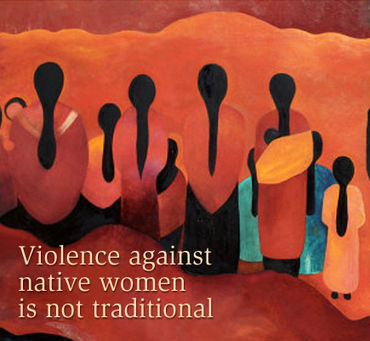
The US supreme court case Oliphant v. Suquamish Indian Tribe ruled that tribal courts and governments have no jurisdiction over non-natives. This ruling created a legal hole that limits the tribal legal system from prosecuting non-native for offensives such as sexual assault. National demographic polls reveal that Native women on reservations have the highest rate of victimization but the least likely of all demographics to have their sexual assaults investigated, see their perpetrators arrests, or to have their cases go to trial (3). Sexual violence against Native American women is an epidemic and of reported cases 86% of Native women defined their perpetrator as being non-native and 80% have described the attacker as white (3). These are very alarming statistics because prosecution of these non-natives is reliant on the federal government. However, 67% of cases reported to the federal government are refused and immediately dismissed. Jurisdictional conflicts have created a hunting ground for rapists and molesters to target native women and even children living on the reservation. “What seems like dry legislation can leave Native women at the mercy of their predators or provide a slim margin of hope for justice. As a Cheyenne proverb goes, a nation is not conquered until the hearts of its women are on the ground”(4).

In the year 2013 the Federal Government reauthorized Violence Against Women Act or VAWA which went into effect in 2015. This partial fix to the jurisdictional problem grated tribes, “the authority to arrest and prosecute non-Indians who commit certain domestic violence crimes within their territory” (5). This small grant of legal jurisdiction leaves a narrow window for tribes to prosecute non-Indians for crimes of domestic violence. This act is significant however, tribal government must have sufficient evidence to claim jurisdiction over a non-native. To prosecute non-natives tribal governments must prove a significant connection between the non-native perpetrator and the native victim. While this act is a step in the right direction, it still leaves many holes that assailants can act upon. It is commonly said that instances of sexual violence peak during hunting seasons, during pipeline construction, or to be committed by truck drivers. Assaults committed under these instances would prove immunity to tribal governments. This policy does hand minuscule jurisdiction to tribal governments but in September of 2018 VAWA will expire. There is uncertainty if it will be reauthorized under the Trump administration considering Trump has not appointed anyone to the head Justice Department’s VAWA office.
It is an undeniable motif through the history of America that federal policy is used as a tool to disenfranchise Natives. Federal Indian policy is used to strip Native tribes of sovereignty and to reinforce racial inferiority. The supreme court case Oliphant v. Suquamish Indian Tribe reiterated both key factors. This court decision that is upheld speaks with authority that Native governments have inferior legal systems and cannot be granted full jurisdiction over their land nor all those who come on to Indian Country. Additionally, this ruling supports the theory that race can justify or excuse grotesque crimes. Jurisdictional laws have made prosecuting non-natives for crimes on Indian Country almost impossible. Factor such as race, relationship between attacker and victim, and extent of crime must all be considered when declaring whether the tribe, state, or federal government has legal jurisdiction. Many visitors can come onto reservations and sexually violate Native women and because of impunity can walk free without being touched. The federal policy currently in place is a large indicator that systematic marginalization has persevered. Colonialism originally violated and divested Native populations and to this day federal policy continues to do so. Federal policy has continued to endorse the rape of Native women and perpetuate the epidemic that has tremendous repercussions to the indigenous population. This issue is large and unfortunately there is no magic solution that will entirely solve this problem overnight. Awareness and pressure must be placed on government officials to consider passing legislation that grants justice, jurisdiction, and elements of independence back to tribal governments. The existence of Native Americans to this day represents the solidarity and strength of Native People. With unity and mass awareness, Natives will overcome these grievances and will continue to show the perseverance and resilience they have since creation.

References:
1. https://law.shu.edu/Students/academics/journals/law-review/Issues/archives/upload/watson.pdf
2. http://www.heinonline.org/HOL/Page?handle=hein.journals/kjpp13&div=15&?&collection=journals
3. Injustice in Indian Country: Jurisdiction American Law, and Sexual Violence Against Native Women by Amy Casselman
4. http://www.nytimes.com/2013/02/27/opinion/native-americans-and-the-violence-against-women-act.html
5. https://www.voanews.com/a/advocates-seek-justice-abused-native-american-women/4261220.html
Books and Scholarly Journals:
2. http://www.heinonline.org/HOL/Page?handle=hein.journals/kjpp13&div=15&?&collection=journals
3. Injustice in Indian Country: Jurisdiction American Law, and Sexual Violence Against Native Women by Amy Casselman
Pictures:
All pictures courtesy of Google
1 note
·
View note
Text
CLAIRE DENIS’ TROUBLE EVERY DAY “It doesn’t fit”

© 2020 by James Clark
The films of Claire Denis tend to elicit a tribute to her audacity. On the heels of that given, there is the thrill of a supposed pronounced modernity. Viewers and reviewers directly understand that narrative means virtually nothing to her, because her forte is “mood” and “texture,” being apparently applied in such a way as to constitute a new and superior logic.
A film like, Trouble Every Day (2001), our challenge today—and quite widely thought to be her breakaway magnum opus—happens to be suffused with not only the narrative of Ingmar Bergman’s film, Scenes from a Marriage (1973), but also Bergman’s, The Passion of Anna (1969); and more Bergman to come. Those infrastructural crises therewith, which Denis handles—as always, with sophistication and delicacy—do not, in fact, countenance cannibalism as a cosmological method. Nor do they countenance a mobilization of neuroscience to develop a medicine to curb sadistic murder by which the gratification remains, but free of messy bloodshed and messy law.
It must be made clear from the outset that Denis has no time, per se, for the infantile fantasy-pastime of vampires. Two broad hints concerning that matter should suffice. In connection with the stately Japanese filmmaker, Yasujiro Ozu, she shuts the door in this way: “I dislike cinephilia and the cult of auteurism” [which is to say, genre, tried and true entertainments, like horror movies]. A second distancing, from a BBC broadcast on the subject of violence in, Trouble Every Day, says a mouthful: “This film concerns what happens when you tangle with something that is stronger than you are.”
Moreover, the gauntlet she tosses down comprises a showdown—involving a Shane being a shame far from well-known and far from readily resolved. We will have many opportunities here, to ponder its features. But its amazing overture should come first.

On a black screen, we hear a keyboard placing three beats, for a baseline, a calm baseline. A slight lift of intensity in that poise discloses a couple parked in the night. The woman’s presence is a sketch of blackness with a touch of her white shoulders and face. She is in her forties as is he. She is a blonde, and she’s smiling. Slowly they kiss. The musical motif spreads unhurriedly. He strokes her throat. A more earthy kiss ensues. A singer with a low voice covers the rest of this vignette, in voice-over.
Look into my eyes.
You see trouble every day.
It’s on the inside,
So don’t try to understand.
(The kiss endures.)
I get on the inside of you.
You can blow it all away,
Such a slight breath.
And I know who I am.
(The screen becomes black. A refrain in strings intensifies the mood.)
Look into my eyes…
Hear the words I can’t say…
Words that defy…
And they scream out loud.

(A Gallic air takes form, in the key of Marianne, having been released from the days of eighteenth-century revolution and reason. [A protagonist, in Scenes from a Marriage, is named Marianne—ironically!] And here the ancient stones, defining the riverbank of the Seine, solidify with a warm golden glow. Upon that stage, two golden pillars and a silver to their right describe the makings of an interplay, an interplay crucial to the work of Ingmar Bergman.)
I get on the inside of you.
You can wave it all away,
Such a slight thing,
It’s just the raise of your hand…
(Two reddish statements, and a golden between, followed by the morning sky with pink and purple clouds racing across the firmament.)
And there’s trouble every day,
There’s trouble every day,
There’s trouble every day,
There’s trouble every day.
(The luminous blue, carrying the title upon black, becomes sliced, rippling on the Seine, a reminder that trouble every day stems from a horde of resentment that life is harder than most want to engage.)
The penultimate coda of this dazzling lightshow involves apparitions in the sky and reverberance down low. Two down beats, and a cut to an appalling love. However, it’s probably advisable to go slowly from the highs to the lows. At the outset of Bergman’s The Passion of Anna, Andreas, a farmer/ artisan smiles when noticing a lovely, unusual color in the sky while trying to repair his broken roof. He becoming a disgrace, unable to counter Anna’s evil; and also Marianne, proving to be deviously rational and frivolously rebellious—they marshaling their incompetence in the twentieth century. But we encounter here a toehold of another, new century which finds “real security” [Anna’s mantra] to inhere in a huge and remarkably homogeneous gratification free from ever having to engage in bona fide grown-up reflection. We begin our conundrum back in the skies with a commercial jet in flight, focused upon the “First Class” area, where a couple of newlyweds toast their honeymoon to Paris with champagne. June, the glowing bride, is about to join the other’s mentioned as being a great disappointment, and even so far as being Gallic. But the disappointments here require innovation to fathom, due to the glue sticking to so many souls. Her first presentation is to refer to the map on the screen confronting her at the seat ahead of her. The schematic diagram resembles the features of a video game, but she discloses, “That must be Denver” [airport]. Denver or not, the payoff, identifying them as very likely Californians, is valuable orientation. Its irony goes a long way, to Marianne’s estranged husband, Johan, a neuroscientist (in Stockholm, in the twentieth century), who was slated to be the new Chair at a university in Cleveland—Cleveland, in the parlance of Bergman, and latterly Jim Jarmusch and his friend, Claire Denis, standing for very poor grades. As it happens, Johan is found to be lacking, and he doesn’t get to enjoy Cleveland. But here—with a kind of behind-the-back-basketball-move��he becomes known to one, Shane, the new groom, also a neuroscientist. And though they occupy discrete centuries, a cinematic current has sprung up (as deft as a Bergman drama), because all these folks carry troubling, though variant, traits, by which one might sharpen a keener sense of present dilemmas and promising delights.

Shane’s namesake, a film figure from the previous century, and a generous loner, in fact, quickly becomes an obverse in the new century. Later that night, he visits the bathroom. His mission, though, is very odd, namely, a protracted fantasy of June, nude, covered in blood. He savors that shock; and now we have to get down to brass tacks about lovemaking in this groom’s perspective. To convey what transpires here in all its baffling flight, we’ll complete that down beat, snubbing all the vivacity having been put on display at that remarkable overture, a gift including a down beat of its very own, whereby a touch of motion reveals a very different world—a world of quiet, infinite ecstasy having been instrumentally joined by a finite sensibility deriving its gifts of action from a matrix of paradoxical love. (The musical opening, by an agency called “Tindersticks,” will have bid to bring us to that love.) That it is vastly bound to a process which “can wave it all away,” becomes the core of this crisis and the introduction of one of the masters of bloodshed, namely, “Core,” on tap by way of that wayward down beat.
There is much about her that is a common hooker, preening that day by her ugly van in a part of the outskirts never having been graced by a serious thought. A truck driver, with his windows decorated with hanging toys, perhaps prizes from festivities of “games of skill,” bites on the lure. (Neither of them can compare with the huge vehicle, particularly its slats of rubber on its side, bringing to mind an elephant.) We see close-up her hyena-eyes; and we link them to the pink clouds there, above a hodge-podge of electrical towers, charmless of course, as is its worn-out golden patina up there. We’re spared the transaction itself; but the kill on the ground tells what has occurred. From out of a pretext of pleasurable coitus, her intensities slide, in a one-track race (where tempering is there to show discipline) to punishment and its dominance, its advantage over others. The grotesque corpse has been not only beaten, but eaten as would a wild beast. The ambiguities of that phenomenon lead us to vast intricacies of contemporary struggle and delight.

We should consider the year—2001—when this film was produced. In Denis’ France, religious fanatics had had a decade-long field day butchering “infidels.” Then there was 9/11, and more of the same. Then a blizzard of school shootings. Then Trump. All of whom fatally lacking intrinsic nuance. This was, then, a world history Bergman never encountered in the form of undeclared wars. That violence, however, as Denis well knows, intersects with a rage of blind self-esteem and a leveraging of effete affluence to dispense with the demands of nature itself. Anna’s rampage could identify a cause—“Security,” however puerile. What our guide is engaging in this film is a tidal wave of energy for the sake of destroying depths, those depths seen in the overture.
The immediate sequel to that slaughter at the highway tends to sprout parody. Core is braced with a former neuroscientist whom everyone calls, “Leo.” (He being in the footsteps of Johan, the self-styled, “sexy-guy”/ psychologist, and whom Shane has far more interest in than with June. That would leave Core, the new Marianne, as a kind of lawyer shark, always on the go.) Leo’s a bust as an inventor of a panacea for cannibalism—Shane’s only interest; but he’s a kind of sheep dog in rounding up wayward, Core. (Though just as basely naïve as the other members of that scientistic cult, Leo is the only one having been visited—slightly—about the farce of his “researches.” [His pratfall falls in line with the sterility of Johan’s embarrassments in the rat-race to bring cogency where, in fact, another range of cognition beckons while at the same time the straitjacket of “hard” science prevails. His dashing optics on his chic motorcycle to finesse his partner’s indiscretion involves his cleaning up the blood and flesh lingering upon her face and body. The gentleness of this concern places him [in fact much older than the other protagonists] as making a hapless equilibrium while the callow pipsqueaks of his sad mistake consult their inner child.) Whereas Johan and Marianne were regarded—by a socialite magazine—to be perpetually honeymooners, the this-century honeymooners sport all woolen apparel, in the spirit of Bergman’s, The Serpent’s Egg (1977); but very much also bringing to the table the rigor of Anna, the slasher of flocks of sheep. (Abel, in The Serpent’s Egg, having also been a blue-blood, and even more dysfunctional than the protagonists in Scenes from a Marriage. Shane and June’s plane, about to land, cruises over Leo and Core’s dead-end. Along a spiral staircase there, we notice a stained-glass window, reminding us of the skillful, bemusing and feckless artisan, Andreas, in Anna’s blistering saga, where an outrage would be a one-person idiocy, not a generational idiocy.
As such, the arrival of the Californian lovebirds at their five-star hotel involves a woman taxi driver dressed like a polite apache—exactly what an LA up-and-coming would like to see through his ridiculously stunted vision. The two of them in their woolen garb (he in baby-blue) create a little buzz when the desk clerk sees that the establishment has been chosen by a “Doctor” Brown. (Blue on the outside, shit on the inside.) Before that, the rather morose visitor rubs his eyes continually, leaving the servant behind the desk ill at ease. Shane, the name being a non-stop joke, demands someone handle the bags, which elicits from the staffer, “Quite so, Mr. Brown!” The porter chosen is a young girl, Christelle, one of the chambermaids on their floor. From out of his adolescent reflexes, he treads closely behind the girl, intent on her nape, and once into their room, with Christelle beginning to make the bed (June helping her), he flops upon it, as so many snotnoses would find to be part of his supposed mystique. (This bit of distemper had been preceded by his formulated carrying of June across the threshold to be deposited on the bed. The threshold included the room’s number, 321—a backward slapdash, failing totally to attain to the sublime.) The unflappable, deadpan maneuvering by Christelle in face of the ugly American, is right out of Samuel Beckett’s play, Waiting for Godot (1953). (Real surreal France, by way of an Irishman.)

Before the full-scale damage gets underway, we want to savor another instance, this time in the old century, of that rugged individualism evincing from Christelle. In her capacity of divorce lawyer, Marianne comes across what she would tend to refer to as an unskilled laborer—the middle-aged client using the term, “housewife.” The latter, otherwise comfortable with an attentive husband, insists that her marriage lacks cogent love, and that she’s determined to attempt to discover the real thing. Marianne, the daughter of a lawyer and looking down her nose at the audacity of small cash-flow, finding something her sainted family wouldn’t touch, concludes the interview with candid frostiness. Shane—a mid-century name for courage—will eventually butcher the young laborer, being a measure of how Bergman’s troubled souls had it relatively easy.
The honeymooners choose Notre Dame Cathedral to extend their questionable tour of the City of Light. Instead of pondering the structure itself, and its functions, Shane, beyond redneck, regards the ancient recipient of intense reflection to be a pretext for recalling a Hollywood melodrama. On an exterior height he thinks to be funny by igniting the Hunchback of Notre Dame and Phantom of the Opera. There also he plays a stiff-corpse vampire. June proves to be only too polite here, showing that (as we’ll discover), whatever her French life before the rich Californian came into it, it has capitulated to an ugly know-nothing. And then a turnaround—not for them, of course—brings to the melancholy trek a sign of deep joy. Up there pissing around, her green headscarf catches a welcome gust, and both of them gaze as it soars above the ancient buildings and bridges. The limestone-white baseline of the City becomes touched by that verdancy. In another Bergman film, namely, Summer Interlude (1951), many such vivacious happenings occur, as if drawing a self-important figure to get real. There it’s called a “glitch.” And the ballerina being summoned to no avail stays mediocre. (Just before Christelle is attacked by the American—June’s aunt having referred to him as “like a church mouse”—the chambermaid soaks her aching feet in a sink, in the nether part of the palace. The supple motions of her simple bath links her to the disappointing ballerina. Christelle [and also Marianne’s annoying client] had lived in a vague but viable terrain of the “glitch,” which appears in spades at that glorious overture. Cadging goodies from the carts, when the coast is clear; lying back on Shane and June’s bed, smoking one of their cigarettes, when the coast is clear; and, when approached by Shane in the deserted changing room, she grabs on to some social climbing by way of the rude rich boy, Christelle has a way to go. But, in a population running on empty, nothing but deep lucidity works. The lady eclipsing Marianne, in the old century, would have had room to slip. The prima ballerina therein could fool herself that a little gust of whimsy amounts to, “I’m actually happy!” Christelle, we realize, doesn’t have the luxury of not knowing how to beat the odds. There is as much metaphor as gore in this film’s disclosure. Cannibalism spreads a wide net, never more lethal than when being “inspirational.”)

Shane, seldom asleep and seldom with June—“I like you June,” is his flaming—has come to the honeymoon capital to reboot a last-ditch effort to find merit in Leo’s hapless cure for going too far. He arranges a visit to Leo’s former high watermark, where the scientist now in control rains on his millennial binge. “So as far as what he discovered, don’t make me laugh! I hope you haven’t come all this way for that nonsense…” Shane, incorrigible, latches on to a maternal colleague of the skeptic—who, were he truly bright, would not be wasting his on time, in that lab, with a daft green liquid on an endless mechanical revolution, in the service of plumbing the human sensibility—who surreptitiously arranges a meeting by which the elusive Leo can be found. (The harsh treatment [scientific advantage] spins Shane into a reverie of another embarrassing disadvantage he had endured at the hands of someone who at least would not be a fan of vaping. [Very much now being a case of choose your poison. Prior to that retreat, we see June in a black, woolen hijab.] The plunge to that painful memory involves the deflated, so-called investigator, covering himself into bed, fully clothed. As with the lab of hard knocks, the flash-back displays human brains and PhDs hoping to confirm the dynamic of consciousness there. But unlike the first critic, sneering at Leo as a feeble theoretical innovator, this apparition, and its flaming redhead boss, shows contempt to Shane, for stealing the possible revenues of Leo’s long and sad foolishness. “You like money, don’t you Shane?”/ “So what? I convinced my boss to take an interest of a Frenchman working on a shoestring budget. That’s all…” The questioner turns to his affair with Core. He, church mouse style, emotes, “Love is not the word for it.” Openly hating this little creep, she asks, “You believed the lawyers, Brown? What about betrayal? What’s your stance about betrayal, Mr. Brown?… Semenal was the game, and you knew it… Huge profits were to be made… You stole Leo’s work and wife. Now get out of here…Get out!”)
The sympathetic lab lady does show the way to Leo (Shane predictably rude). But the real gift from that transaction is another of the ladies in lab coats at the former lair of Leo wishing she could have a six-month vacation. Overhearing that impossibility, the one who fired Leo has going through his mind, and giving us a flash-back, the permanent vacation of the accident-prone mediocrity. (This extended tapestry of despair lives up to Bergman’s theatrical incisiveness.) Leo tells the power that be, “You know that I don’t ask for much. Just a favor. I need a little time. You can help me…” But getting things right may take initiative first, and then a “favor.” The response to Leo seems to corroborate that action. “It doesn’t fit!…It does not fit!” [a stupid, essentially cowardly gesture, goes nowhere but disaster].
Shane arrives in time for the auto-de-fe which Core choreographs after another kill, this time in their own abode. Leo had arrived, to stand in that conflagration, relieved, at last, from a disaster of smarts, beyond his vision, and, moreover, a failure of courage on the scale of an epidemic. (Shane, too, had arrived after the blaze had begun, where he felt necessary to both attempt to rape her, and, facing her teeth, kill her—making his getaway, as would Anna.) Two compensatory moments have been brought to bear. Although the death toll includes the odd couple and their worm-worn exterior—a grateful dead on top of a perverse career—the lovely collie dog included from out of a “glitch”-prone taxi culture our protagonist uses, puts the cold American freak to shame; as does the tapestry of blood by Core (not unlike the work of Jean-Michel Basquiat).

But, come to think of it, there’s a third lift, this time wafting into the horror from a long time ago, namely, the Alfred Hitchcock “mystery,” The Lady Vanishes (1938), also on a cusp where the planet teeters toward utter nullity. Across the way from Leo and Core’s, there are two young men presenting many surprises. The first being, that though they speak French, they are as British blokes as the British blokes in the Hitchcock film, rushing across the Continent, by train, to catch the last days of the cricket Test Match. Their crowning indiscretion is curious concupiscence about the bizarre fortress and the glimpses of Core at her upper windows’ prison. After some false starts, they breach the barricades (Leo now at work as a mild-mannered general physician, in lieu of Superman), and one of them falls prey to Core’s predilection for shock and awe. That would be the risk-taker of the pair, hungry for perhaps going viral on Twitter and Facebook. (This recalls the puerile ballerina, in Summer Interlude, after her first bout of lovemaking, claiming that the boy, far more capable of love than she, will now brag about it to his friends.) His avuncular buddy proves that he is more than a one-track mind, warning often that the break and entry should be rapidly abandoned. Eventually, this other disturbing pair of love birds leaves Core drenched in the bloke’s blood and with shards of the boy’s chin sticking on her cheeks, at which time the petrified friend retreats to the house across the street. In the Hitchcock, both cricket crazies claim that they had never noticed that there was an elderly lady, across the aisle from them, not to mention that she had now become missing. Missing links being an epidemic.
We’ll catch Shane up, in the aftermath of dragging a bloody Christelle to a less used area, as if she were a victim of the bull ring. He buys a sweet puppy, in hopes of compensating June’s being largely abandoned in the Love Capital. (On the way home, standing in the Metro, he sandwiches the little innocent between him and a woman. A young woman glares at the jerk, but glaring is all she does.) June has found the pup, and also she has located her husband, in the shower. She calls out several times, with some asperity. He ignores her calls, concerned with giving himself a much-needed clean-up, where blood overtly streams on the shower curtain. The shower eventually ends, and he’s seen in close-up, as if all is well. Pan to June, giving him a stressful look. Then close-up to him and his patented dead eyes. She again is seen, with the scab of her cut lip. “Thanks for the dog,” she says, knowing it won’t be theirs for long. He flashes a facile grin, and says, “I feel good… C’mon…” They kiss. She notices a little flow of blood coming down the shower curtain. [More Hitchcock.] “I wanna go home,” he mumbles. “OK,” she woodenly tells. And the blood-red leather gloves she’s wearing holds the disinterested creature. A muffled roar. A close-up of her eyes discloses a puzzle. Her eyes suddenly open wide. Another stream of Christelle’s blood occurs on the curtain; it might have proved embarrassing, if anyone there had cared a damn. Losing her evocative green scarf, she ends up with a Notre Dame tourist scarf with four views of Jesus.
The partnership between Denis and Tindersticks represents a unique inroad of the history of cinema. (Compare this innovation with Bergman’s standing pat with mainstream classical composition, perhaps measuring the distance from old to new). From out of the recent disc, “No Treasure but Hope,” here’s a bit of lightning readily readable. Whereas the soundtrack of “Trouble Every Day” comprises a melancholy tone poem, the tune here uses its pregnant thrum to make merry with irony and gentle love.
https://www.youtube.com/watch?v=7q9MY-tQbpw
0 notes
Text
Live Gig Review: Gerry Gibbs and Thrasher People “Our People” record release party, 10/18/19 at Nublu, NYC
Gerry Gibbs: drums, percussion, vocals, keyboards; Alex Collins: Fender Rhodes, Mini Moog, and vocals; Chien Chien Lu: vibraphone, glockenspiel and vocals; Jean-Baptiste-Bocle: vibraphone, Mallet Kat, organ, percussion and vocals, Jeff Lederer: alto saxophone, bass clarinet, vocals and synthesizer; Marlon Martinez: acoustic and electric basses, vocals; Kyeshie Gibbs: vocals and percussion; Debbie Major: vocals, electronic vocals and percussion. With special guest Ravi Coltrane: sopranino, soprano and tenor saxophones.
A record release party is different from any other premiere gig. The artist is often surrounded by close associates and friends, the venue whether it be a well known club or other space; the atmosphere just feels different, more electric. The music is super fresh, the ideas of new possibilities inside the music is truly in the realm of the unknown. At Nublu in Manhattan on October 18, 2019, Multi instrumentalist Gerry Gibbs and his nine piece Thrasher People was a force, debuting for the first time live, the music of Our People (Whaling City Sound) released in June. Our People is truly Gibbs' most ambitious album to date, his twelfth as a leader (fourteen, if you count that two of his albums are double discs). It is epic music that defies category on the scale of recordings like Yes' Tales From Topographic Oceans, Return To Forever's Romantic Warrior, Eberhard Weber's The FollowingMorning, the Pat Metheny Group's swansong The Way Up or Antonio Sanchez's The Meridian Suite and Lines In The Sand. Live, the incredibly challenging yet completely satisfying music mirrored it's recorded counterpart with precise execution, but expanded greatly as the best jazz does live. This was largely because of a sterling ensemble including Alex Collins on Fender Rhodes, Mini Moog, and vocals, Chien Chien Lu on vibraphone, glockenspiel and vocals, Jean-Baptiste-Bocle on vibraphone, Mallet Kat, organ, percussion and vocals, Jeff Lederer on alto saxophone, bass clarinet, vocals and synthesizer, Marlon Martinez on acoustic and electric basses, vocals and rounded out by Kyeshie Gibbs on vocals and percussion, and Debbie Major on vocals, electronic vocals and percussion with special guest Ravi Coltrane on sopranino, soprano and tenor saxophones.
The album's production was a very involved process with 5 musicians playing over 40 instruments and vocals being overdubbed some 20 times, so the fact the music was performed live in real time without sequencers was incredibly impressive. The opening “Scene 18” lost none of it's power as Gibbs whipped a marshal beat . The music, modeled after the feeling of a huge budget film, such as Ben Hur was nothing short of majestic, the nonet sounding like something much larger. “The Streets” was like something out of a blaxploitation film, Bocle and Collins really digging into their solos. Collins was particularly humorous because of his many permutations of The Lick used as a running motif. If anyone had a drink in hand, it could make a fun, and goofy drinking game. Chien Chien Lu's vibe solo on the second section was full of ripe ideas.
There were three players in particular, though the whole ensemble was wonderful, that shone above the rest: Alex Collins, Chien Chien Lu, and recent LA to NY transplant, bassist Marlon Martinez. The affable Gibbs stated that he didn't want to kill the mood with “such a morbid title” but introduced “Boys Sent To Die” as being inspired by the young men who died in the senseless Vietnam war, a sobering reminder of how pointless war really is. A long bass improvisation segued into the composition. Martinez was the star student of Stanley Clarke, and upon the bass innovator’s suggestion, Gibbs checked him out. Martinez's solo began with percussive slaps on the acoustic bass body. and some ringing harmonics. From there he dove into a wide array of melodic explorations as well as some dazzling work high on the fingerboard, that while having Clarkian echoes, showed a player that will be a major name to watch.
The Taiwan born but now NYC based Lu has played with a variety of groups, both jazz and classical, and is now a member of Jeremy Pelt's quintet. Fluidity is a word that comes to mind when thinking of her bright and bold ideas. The duet she had with Jean-Baptiste Bocle was marvelous, the two bounced ideas off each other as if the two vibraphones were one, Lu's mallets traipsing down the metal bars in bluesy rhapsody. When it came time for the group to run down the self explanatory, Mozart flavored, “Chick Corea”, it received a strong adrenalin boost from a double timed samba not present on the record, with an energized Mallet Kat solo, from Bocle, shades of Mike Mainieri's MIDI'd vibes in Steps Ahead. Gibbs' drum solo was a mix of melodic motifs and barrages of 16th and 32nd tom fills with the power of Billy Cobham and speed of the late Alphonse Mouzon.
Ravi Coltrane was the evening's special guest, and the long drone of sampled sitars was the perfect cushion for his vocal, yearning sopranino saxophone, before switching to tenor on the cheeky “Oh Yeah”. “Oh Yeah” has a self aware humor that reflects Our People's wide range of influences from 70's spiritual jazz, Donald Byrd albums like A New Perspective, I'm Tryin' To Get Home, prog rock, film, and easy listening (!). The piece, with it's hypersonic swing made it especially endearing. The “Dance Of The Freedom People”, an ode to the Art Ensemble of Chicago had a thrilling alto and tenor duel between Coltrane and Lederer and was prefaced by a side splitting Gibbs story in which he, Lederer and several others were decked out like the AEOC in a performance that ended with the cops being called and a bird pooping on Gibbs' head. Debbie Major had a wonderful feature on an arrangement of Stevie Wonder's “Overjoyed” and “Living For the City” originally featured on We're Back with Kenny Barron and Ron Carter. Coltrane's lyrical soprano complimented her soulful, R&B delivery. The evening closed with “The Final Message”, with a Gibbs beatbox solo that'd even make Rahzel blush and an audience singalong on “Friends Before We Were Friends: Part 2.”
Gerry Gibbs and the Thrasher People exhibited a breathtaking display of instrumental and compositional prowess. In the streaming era with it's pick and choose mentality, the notion of an album, more so then ever before, is a cultural rarity. With music so complex, it was truly amazing to see it performed so effortlessly, especially on a first night. If this music is taken on the road, it will provide an earthy, cerebral, uplifting mix that will stick in the minds of all that hear it. It is important to remember to approach it with an open mind, with no conception of genre or expectation it is some kind of “world music” informed by the multicultural makeup of the band. It is Gibbs being inspired by the friends he's made all over the world, and like multi instrumentalist Stephan Micus, brings an idiosyncratic approach to music that is thoroughly enjoyable, and the Our People album itself is one of the best releases of the year. Special thanks goes to Gerry Gibbs and Lydia Liebman.
0 notes
Text
Music Review: The Cramps - The Smell of Female (Vinyl)

Oh man, where do I begin with this one, honestly? It’s one of my absolute favorite live albums, but that’s coming from the fact that I’m a massive Punk Rock fan as well as a fan of the Cramps.
I guess to start it off basic, it’s a slight deviation from what you would expect from something along the lines of Bad Music For Bad People but has classic Cramps smacks like The Most Exalted Potentate of Love and Psychotic Reaction (which is actually a cover from the classic 60′s band, The Count Five). Running alongside those hits are mostly back catalogue tracks that are burned through with sweltering precision by the driving distortion of rhythm guitarist Congo Powers and droned through with articulation by drummer Nick Knox. The bigger of these hits being You’ve Got Good Taste and Call of the Wighat, which line up strategically behind Most Exalted Potentate of Love to take up the majority of Side A. The latter being very proto-Dead Kennedys a la Chicken Farm (Frankenchrist 1985) which can be a broad example of how the Cramps influenced bands within their own realm to the point of exceeding popularity. Keeping with his usual motif, Lux Interior keeps it as real as ever in this one, boasting the brash charisma and one-off quips between tracks to keep the crowd moving before thundering through another psychobilly beatdown, giving, not only, the feeling of an actual live album, but the somewhat rare, feeling of actually being there, helped along by the excellent engineering of Paul McKenna, balancing the sound of the crowd nicely with the blast of the band themselves.

Time to roll through the main aspects of the review.
The Basic Facts
Recorded between February 25-26 1983, at the Peppermint Lounge in New York City. It definitely wasn’t during the beginning of the band’s existence (starting in 1976) but was during the meat of the band’s tenure during the CBGB Punk Rock Movement, helping to establish, and reaffirm their prowess as a live entity.
Having only a run time of roughly 32 minutes, its very befitting of a punk record as well as a live record, but the vinyl itself sets a good halfway point on the record allowing for a solid flow during the halfhour set.
The Tracks
Thee Most Exalted Potentate of Love: An exemplary track of the Cramps style and sound, easily the longest lasting sounding track on the record and an excellent use as an opener track.
You Got Good Taste: One of the bigger tracks on the album; it displays the off yet well placed croon of Lux Interior while allowing Ms. Poison Ivy to scream in with a guitar sound and solo that makes me quickly turn my head to Dan Auerbach and would probably result in him swiftly looking up and beginning to whistle anxiously.
Call of the Wighat: I’m serious when I say that Chicken Farm by the Dead Kennedys is a freakishly resemblant track. Its driving, loud, thunderous and just overall, good. Probably my favorite on the album.
Psychotic Reaction: Another one of the better tracks on the album and one of the best covers ever, in my opinion. Lux Interior’s vocal work is definitely different than John Byrne’s of the Count Five, but I’m sure he pulled a Johnny Cash - Hurt and made it entirely his own and it can’t be denied. Musically strong as well, Lux’s harmonic work going nicely with the guitars and the transitioning sounding wonderful. There’s this certain shift between these 2 riffs that they just nail a lot better than the Count Five.
The Production
No need for bullets here, its solid. Its one of the better live albums that’ll you’ll ever hear, boasting the nice balance between the sound of the band and the sound of the crowd and Lux’s one-liners between tracks. The clarity of the stereo is magnificent. Listened with a pair of Marshall production recording headphones (before they blew out, whoops) and the layering of the guitars, needle sharp Poison Ivy and thick bellowy, Congo Powers, mixed with the slightly-to-the-left drum tracking thats almost drum-machine worthy, makes for a balance that’s more than clear, but furthers the enjoyable experience. Its also not often that you catch live records in the Punk realm that are this clean sounding yet still raw and in your face (Return to the Black Hole by the Adolescents, maybe?).
The conclusion to this is pretty simple, if you like Punk Rock, the Cramps, or even just rock in general, give it a listen, its bound to catch someone’s ear, one way or another. The replay factor is strong, at least to me it is. The Vinyl rarely makes it back into the alphabetical stack with the others, always remaining on the “now playing” stack on my table. It’s good. Almost Bad Music for Bad People good, but that little difference most assuredly is not a negative, promise.

Final Score?
8 / 10
(But definitely their best live album)
#music review#the cramps#rockabilly#psychobilly#punk rock#lux interior#poison ivy rorschach#nick knox#congo powers#peppermint lounge#1980s#reviews#music#vinyl#records#record#vengeance records#retro#collection
1 note
·
View note
Text
Thomas Uram’s numismatic journey: From young Lincoln cent collector to the “Super Bowl of numismatics”
By Louis Golino
Thomas Uram began collecting coins in 1971 and joined the ANA as a junior member in 1974. In addition to having been a collector for almost a half-century and an award-winning exhibitor and certified award judge at many coin shows, Tom is a key leader within the numismatic community involved in several of the leading organizations. He has been president of the Pennsylvania Association of Numismatists since 2011, was elected in 2017 to a two-year term as a member of the ANA Board of Governors, and has served since 2012 as a member of the Citizens Coinage Advisory Committee. In December 2018, U.S. Treasury Secretary Steven Mnuchin appointed Tom to a one-year term as chair of the CCAC. He is also a member of many other numismatic associations and clubs.
I have known Tom for years, and we often discuss coins, especially modern curved issues. I recently spoke to him about the highlights of his extensive service as a numismatic leader and about how he views changes taking place in the hobby.
Hover to zoom.
Louis Golino: What specifically about coins and collecting appealed to you at a young age?
Thomas Uram: Tom said that his uncle gave him a Red Book and a junior ANA membership at a young age. Seeing the various values of coins listed in the Red Book is what piqued his interest in coins and instilled the thrill of the hunt. Around his 12th or 14th birthday, his uncle took him to the Pittsburg Coin Company, which was a very small shop, and he picked out a 1909 VDB Lincoln cent and some other coins that came to $60. He was very pleased that his uncle paid his tab.
LG: I know from our discussions that you are especially passionate about modern coins, particularly modern world coins. What is about these coins that attracts you? And do you also collect older coins whether American or foreign?
TU: Tom said that he is attracted to foreign coins because of the “interesting topics, nice designs, and the scarcity of low mintage issues.” He mentioned the U.S. Mint-Royal Australian Mint two-coin domed Apollo 11 set as an example of a recent item that appeals to him. He added that as for the growing number of curved coins, of which he is trying to assemble a complete set, it has reached the point where he is feeling overwhelmed. As for older U.S. coins, his philosophy is quality over quantity, and he has specialized in the two-cent series over the years, focusing on high-grade examples. He has also picked up some ancient coins.
LG: How do you view the revolution in modern world coins of recent years, specifically the amazing innovation we have seen in the types of coins issued? Has it gone too far?
TU: Tom answered that there have always been odd-shaped coins like the Spanish shipwreck cob coins and that the innovative types of coins being issued today by world mints are not a fad and are here to stay. He is currently giving thought to doing an exhibit of superhero coins. He also mentioned that he frequently collects by theme, which is also useful when putting together exhibits at coins shows — something for which Tom has been well-known for many years.
BHF-S-R-01 — 2020 Basketball Hall of Fame Commemorative Coin Program — Silver Reverse
LG: Should the U.S. Mint push the boundaries of innovation in its coins further such as by issuing gilded coins or coins with color?
TU: Tom mentioned that during the July 17 CCAC meeting about the forthcoming 2020 Basketball Hall of Fame commemorative program, the Mint said it is considering selective color application to the clad half dollar and silver dollar but not to the $5 gold coin. He said the committee’s members have over time come around to the idea of doing this, and he was pleased to hear the Committee on Fine Arts that met the following day to consider the basketball coins also supports this possibility, but that it is the Mint that will make the final determination of what would work best.
LG: You said to me recently that your work with the U.S. Mint, especially serving on the CCAC since 2012, is the most rewarding aspect of your extensive involvement in the hobby. Please tell us why that is the case.
TU: Tom explained that back when he received his 25th-anniversary membership medal from the ANA he went to Chicago for the meeting and did not know anyone. But things have changed a lot as a result of his involvement with hobby groups. Since then he has been elected to the ANA Board of Governors and worked with the Mint by serving on the CCAC. He said it is the relationships with other people that he has formed in the hobby that have been most important and rewarding and that “it has been great to have been a small part of the Super Bowl of numismatics.”
LG: And how has serving as chairperson of the CCAC since December of last year been different from serving as a regular member of the committee?
TU: Tom said that when he first started serving on the CCAC in 2012, he discovered that changing things was more complicated than he had expected, that “it is hard to turn the battleship around.” But he believes that over time he has been able to bring a greater awareness of numismatics to the Mint through his work on the committee. He noted that today the Mint is more engaged in educational outreach than in the past and that seeing all this progress at the Mint has been very gratifying.
LG: What do you consider to be the kind of design elements that a coin with a great design should have?
TU: Tom said that a key element of creating great designs involves the Mint balancing the interests of more advanced collectors with those of newer collectors and that issuing coins with topics collectors find compelling is also very important. In addition, it is up to the designers and engravers to come up with great coins. He said things have been moving in the right direction during the period he has been on the CCAC with U.S. Mint coins having received two Coin of the Year awards in 2017 and another two this year — the 2017 American Liberty 225th Anniversary high-relief gold coin was named Best Gold Coin, and the 2017 Boys Town silver dollar was named Most Inspirational Coin.
LG: What were the highlights of your experience serving as an ANA governor?
TU: Tom said the “highlight would be having served as an ambassador from the ANA to the Mint and various coin clubs and helping to get them engaged with the ANA” as well as building bridges between them to help each other.
In addition, he noted that “the ANA needs to hit the refresh button and rebrand its image for millennials” and that building and growing the ANA is not just about how many new members you can add but about having members who are dedicated to the organization.
Although his term as governor is about to end, he plans to stay involved to the extent the new president, Col. Steven K. Ellsworth, wants him to. For example, he believes that “how we engage and partner with other organizations like Heritage Auctions or Wizard Coin Supply for mutual benefit” is important. It is also important for the ANA to focus on what legacy members are leaving the association such as in their wills and that he would like to see a committee separate from the board look into this.
LG: How do you see the future of the hobby? Are you one of those people concerned about the greying of numismatics?
TU: “The hobby is changing rather than greying,” Tom said, adding that there are many ways to encourage younger people to collect. He said that you don’t have to purchase a lot of coins to be involved with numismatics and that focusing on educational projects can be very rewarding. For example, one could take the John Marshall commemorative silver dollar and use it as the basis for a presentation to a coin club. “There is too much emphasis on the monetary side” of collecting, and “there are many ways to collect.”
Louis Golino is an award-winning numismatic journalist and writer specializing primarily in modern U.S. and world coins. His work has appeared in Coin World, CoinWeek, The Greysheet and CPG Market Review, The Numismatist, Numismatic News, FUN Topics, The Clarion and COINage, among other publications. His first coin-writing position was with Coin Update.
In 2015, his CoinWeek.com column, “The Coin Analyst,” received an award from the Numismatic Literary Guild for best website column. By 2017, he received an NLG award for best article in a non-numismatic publication with his “Liberty Centennial Designs,” which was published in Elemetal Direct. In October 2018 he received a literary award from the Pennsylvania Association of Numismatists (PAN) for his article, “Lady Liberty: America’s Enduring Numismatic Motif,” that appeared in The Clarion in 2017.
❑
Follow us on Facebook and Twitter!








0 notes
Text
*Hình ảnh lấy từ Google, Tumblr và Twitter
** Tiêu đề phỏng theo hai bài rant Normin’ the Movies (tán nhảm về phim của anh chú Norman Reedus) được viết cách đây khá lâu, “Theo-ing” chẳng qua là “gặm phim của Theo James” mà thôi (theo từ điển Joel-dictionary)
Warnings: ngôn ngữ không đứng đắn, xen lẫn tiếng Anh và tiếng Việt, tán nhảm là chính, spam hình Theo cũng… chính nốt, ý kiến hoàn toàn chủ quan, spoilers đầy rẫy
Lại là bạn Joel. Bạn đã hết bị cấm túc tập thể và đi làm trở lại. Tuy nhiên, trước khi trở lại công ty bạn đã kịp ‘gặm’ thêm ba phim nữa của Theo — con người có chiếc tên quá dài mỗi lần cần liệt kê bạn đều phải Google. Thực ra ban đầu tính viết review ngăn ngắn cho phim thứ ba trong loạt phim này — Sanditon — thôi nhưng ngẫm lại bạn cũng muốn rant chút ít về hai phim còn lại, thế nên gộp hết vào một post cho gọn gàng đẹp đẽ.
❶ LONDON FIELDS (2018)
youtube
Đạo diễn: Mathew Cullen
Diễn viên: Amber Heard, Theo James, Billy Bob Thornton, Jim Sturgess
Tóm tắt: Một nhà văn không thành công mấy (Billy Bob Thornton) dọn đến Luân Đôn qua một chương trình trao đổi nhà để tìm cảm hứng sáng tác. Tại đây, ông quen ba người: Keith (Jim Sturgess), một tay cà lơ phất phơ nợ đìa; Guy (Theo James), một người đàn ông có cuộc hôn nhân kém hạnh phúc; và Nicola Six (Amber Heard), một cô gái xinh đẹp. Nicola tự nhận có khả năng đoán trước tương lai và cô biết ngày, giờ, địa điểm cũng như cách mình sẽ chết, chỉ danh tính hung thủ là mờ mịt. Cô tin rằng một trong ba người đàn ông sẽ là hung thủ và bắt đầu dây dưa tình cảm với cả ba nhằm tìm ra chân tướng.
Điều đầu tiên bạn Joel muốn nói là bạn rất thiếu thiện cảm với Amber Heard vì scandal bạo hành Johnny Depp của chị gái này; nếu không vì Theo góp mặt trong phim còn bản thân thì quá chán vì chưa tìm được phim gặm thì chắc chắn bạn không xem London Fields. Xem xong, bạn lên mạng đọc review và biết phim bị đánh giá rất tệ, với mức điểm IMDB dưới trung bình và mức điểm Metacritic chỉ 16%. Tuy thích Theo lắm nhưng bạn phải thừa nhận điểm chấm không hề oan và pha fanservice của Theo không kéo nổi cảm nhận của bạn với phim.
Có lẽ London Fields là một trong số ít phim khiến bạn phải thốt lên “What for?” (Chi vậy?) bởi bạn chẳng hiểu nổi mục đích và động cơ của hai nhân vật dẫn dắt câu chuyện: Nicola và hung thủ. Trước hết nói về hung thủ nhé. Hint: trong ba người đàn ông, người có ít — hay không có — lý do ra tay với Nicola nhất chính là hung thủ. Kinh nghiệm xem phim, đọc truyện trinh thám cho biết giết người cần có động cơ, nếu không vì động cơ thì vì thôi thúc và loại này rơi vào thần kinh hay serial killer rồi. Vấn đề là hung thủ không rơi vào hai trường hợp này. Bạn Joel nghĩ hoài nghĩ mãi vẫn chưa thông lý do hung thủ giết Nicola; chẳng lẽ hung thủ ra tay vì muốn có một kết cục thật nên thơ, thật đi vào lòng người nhưng sau cùng lại thành ra đi vào lòng đất hay còn ẩn ý sâu xa thâm thuý nào đó bạn kém cỏi không đào bới được?! Sang nhân vật Nicola bạn càng khó hiểu hơn. Rốt cuộc mục đích của chị gái là gì khi chị miệng nói muốn tìm hung thủ nhưng hành vi cố tình trêu đùa tình cảm, lừa tình lẫn tiền của người khác chẳng khác nào khiêu khích người khác mau mau chóng chóng ra tay với mình đi?! Nicola từng bảo nhà văn không được viết chị thành nhân vật ‘phẳng lỳ’ (one dimension) trong tác phẩm ông đang thai nghén nhưng thật ra chính Nicola lại là một nhân vật ‘phẳng lỳ’ cố làm ra vẻ bí ẩn, sâu sắc nhưng thật ra nông cạn và nhạt toẹt vì chị không có động lực (motivation) làm khán giả đồng cảm cũng như bất kỳ nét tính cách nào gỡ gạc lại hành vi khó đỡ để khán giả động lòng khi cái chết đến với chị — có chăng là chút… hả hê (bạn Joel đấy). Nhân vật trung tâm của phim như vậy thì hỏi phim sẽ đi đâu về đâu?
❷ ZOE (2018)
youtube
Đạo diễn: Drake Doremus
Diễn viên: Léa Seydoux, Ewan McGregor, Theo James
Tóm tắt: Trong tương lai không xa, con người tạo ra được những người máy giống hệt người để làm bạn đời. Trên cái nền đó, Zoe (2018) kể câu chuyện về một người máy đem lòng yêu người đã tạo ra mình.
“Tại sao anh tạo ra tôi?”
Nếu câu hỏi này xuất hiện trong phim kinh dị-khoa học viễn tưởng thì câu trả lời không thoả đáng sẽ dẫn đến việc người bị hỏi bị người hỏi lấy làm vật thí nghiệm và kết quả thì… không dám nhìn luôn (người máy David trong Prometheus (2011) — có ai xem phim đó chưa?). May mắn thay, Zoe không phải phim kinh dị mà là phim tình cảm xoáy quanh mối tình giữa một người máy (Léa Seydoux) và một người thật (Ewan McGregor), vậy nên dù câu trả lời không thỏa đáng chút nào thì cũng không xảy ra hậu quả nghiêm trọng, ngoại trừ người hỏi — người máy tên Ash (Theo James) — buồn lòng thôi.
Người máy biết buồn lòng không nhỉ?
Chịu. Chỉ biết Ash có tình cảm (với một người máy khác) và khi trở thành trái tym bên lề thì hắn tỏ ra ghen tỵ, tỏ ra buồn bã, đến mức hắn yêu cầu được shut down (tương đương với cái chết). Tiếc rằng hắn chẳng phải nhân vật chính nên phim chả buồn khai thác thêm về hắn hay cho hắn một cái kết, và câu chuyện của hắn vẫn lửng lơ như câu hỏi vu vơ của người tạo ra hắn: “Nếu tôi tạo bạn đồng hành cho cậu thì cậu có vui không?”
Bài học rút ra: Người máy mới ‘chào đời’ thì nên cho đọc Xúp gà cho tâm hồn hay… sách thiếu nhi chứ đừng để nó đọc mấy cuốn tiểu thuyết của Kafka kẻo lại bị khủng hoảng về sự tồn tại rồi trở thành người máy tự kỷ.
Bạn Joel thừa nhận mình rất lơ đễnh khi xem phim (vừa xem vừa dịch fic nó vậy đấy *icon cá mập đớp sóng), không để ý mấy đến chuyện tình của hai nhân vật chính mà chỉ tập trung vào những đoạn có Ash; Zoe không phải gu của bạn và lý do duy nhất bạn xem phim là vì Theo. Diễn xuất của anh, như thường lệ, vẫn không có gì để chê cả, và qua sự thể hiện của anh, Ash vừa có sự ngây thơ của một đứa trẻ vừa có sự u buồn của một kẻ biết rõ trong mắt con người thực sự, hắn chỉ là một cỗ máy, không bao giờ ngang hàng với họ bất kể tâm tư và tình cảm của hắn giống họ đến mức nào.
Một điều khá bất ngờ với bạn là Ridley Scott có tên trong dàn sản xuất Zoe. Hẳn Ash không nên shut down mà nên sang chơi với David và Walter cho vui cửa vui nhà.
❸ SANDITON (2019–)
youtube
Đài: ITV
Diễn viên: Rose Williams, Theo James, Leo Suter, Ruth Kearney, Charlotte Spencer, Kris Marshall
Tóm tắt: Được chuyển thể từ tiểu thuyết còn dang dở của Jane Austen, Sanditon theo chân cô gái Charlotte Heywood đến thị trấn ven biển Sanditon, nơi cô tìm thấy cả tình bạn lẫn tình yêu.
Bạn Joel hay gọi đùa Sanditon là ngôn tình phương Tây vì nó đủ các yếu tố thường thấy ở ngôn tình: nữ chính Charlotte (Rose Williams) xinh đẹp, trong sáng nhưng rất có chính kiến; nam chính Sidney (Theo James) đẹp chuẩn soái ca, ban đầu lạnh nhạt (hay cà khịa nữ chính và có vài lời nói lẫn hành động vô duyên vãi cả chó mèo *icon pacman*) nhưng thật ra là người ấm áp có quá khứ không vui (nếu mỗi lần gặp kiểu nhân vật thế này bạn Joel được một đôla thì giờ bạn giàu to rồi); nam phụ James (Leo Suter) đẹp trai si tình với nữ chính và cuối cùng là nữ phụ Eliza (Ruth Kearney) xinh đẹp nhảy vào phá chuyện tình nam-nữ chính. Đấy, thêm motif ngược tâm yêu nhau say đắm nhưng vì hoàn cảnh nên đành chia lìa (spoilers alert: Sanditon có motif này) là tròn vị ngôn tình!
Tại sao bạn Joel xem ngôn tình trong khi đây là thể loại bạn né xa ba vạn dặm? Thực ra ban đầu bạn không có ý định xem Sanditon (nghe đến series là máu lười trong bạn chạy rần rần), nhưng (lại nhưng!) bạn cần gì đó để xem sau khi đã gặm hết những phim của Theo mà bạn có thể gặm (bạn muốn xem Golden Boy hơn mà không down được) nên thôi thì cày nốt bộ gần đây nhất của anh giai — Sanditon, xem xem anh giai diễn xuất thế nào để các fan gái trên Twitter và Tumblr ca ngợi dữ dội đến thế.
Sau đây là những điểm Sanditon làm tốt và bạn chắc chắn sẽ đề cử nó với những bạn ghé qua blog (nếu thích phim thì sau đó tham gia hội #Save_Sanditon đòi mùa 2 trên Twitter cho vui).
Source material tốt. Sanditon chuyển thể từ tác phẩm của Jane Austen, dù là tác phẩm chưa hoàn thành, thì ít nhiều nội dung của nó không thể quá tệ. Tuy trong phim có một số tình tiết hơi lỗi thời với thế kỷ 21 nhưng xét tổng thể thì phim rất khá, đủ để giữ chân bạn Joel đến hết phim chứ không vì quá cringey mà phải bỏ giữa chừng.
Mini-series có 8 tập thôi! Động lực chính cho bạn cày hết Sanditon là đây! Phim có 8 tập à, bạn xem một, hai ngày là hết sạch, vừa không tốn thời gian vừa đỡ tốn công download (tưởng tượng phải download một phim 40 tập là bạn muốn drop ngay và luôn). Vì số tập ít nên nội dung Sanditon khá cô đọng, không có những tình tiết thừa thãi hay dây dưa, sến súa mất thời gian.
Bối cảnh, phục trang đẹp. Sanditon có những cảnh rất đẹp, rất thích mắt như cảnh vách đá bên bờ biển Charlotte đi dạo cùng Sidney hay cánh đồng hoa tím Charlotte đi picnic với Georgiana. Nhiều lúc bạn có cảm tưởng chỉ cần cho nhân vật đi qua đi lại chẳng vì mục đích gì ngoài cho khán giả ngắm cảnh cũng được (nhưng không có đâu, phim ngắn, lấy đâu ra thời lượng cho những cảnh như thế). Về phần phục trang, bạn Joel sẽ không giả vờ mình hiểu biết tý gì thời trang Regency, bạn chỉ thấy được tổ phục trang của phim rất chăm chút những trang phục nhân vật khoác lên người, từ trang phục sinh hoạt bình thường đến xiêm áo dự tiệc. Chẳng vậy mà một bạn trên Twitter cảm thán từ nay trở đi các phim chỉ nên cho Theo mặc trang phục Regency thôi, vì anh giai mặc đẹp quá thể đáng.
Nữ chính OK. Mỗi khi xem phim có nhân vật chính là nữ, hơn nữa còn là phim tình cảm, bạn có một ước ao bạn có một khát khao rằng chị gái xin đừng hãm, đừng thánh nữ, đừng phá game, cũng đừng làm bông tuyết đặc biệt hay trung tâm vũ trụ và mọi thứ đều xoay quanh chị, đơn giản vậy thôi. Charlotte Heywood không thuộc thể loại nào trong những thể loại trên và điều này góp phần không nhỏ vào mức độ bạn enjoy phim. Bạn không khẳng định mình thích Charlotte nhưng đây là một nhân vật likable, mạnh mẽ, có chính kiến và thông minh; tuy chị gái có pha xử lý hơi đi vào lòng đất một chút ở tập 5 nhưng không đến nỗi quá đáng đến mức làm khán giả ức chế. Bên cạnh đó, những đoạn chị gái và nam chính cà khịa nhau ở mấy tập đầu là một trong những thú vui cuat bạn khi xem phim.
Tuyến nhân vật phụ đặc sắc. Sanditon không chỉ xoay quanh nữ chính Charlotte cùng chuyện tình cảm của chị với nam chính Sidney, phim còn dành thời gian cho tuyến nhân vật phụ cùng mạch truyện của họ. Nhờ vậy, nhân vật phụ trong phim không tồn tại để làm nền cho cặp đôi chính mà được phát triển ‘tròn trịa’ — mỗi nhân vật đều có tâm tư, tình cảm, động lực của mình, đều để lại dấu ấn trong lòng người xem và góp thêm một gam màu vào bức tranh phong phú của Sanditon. Và để khán giả cảm nhận được cái hay của từng nhân vật thì không thể không nhắc đến…
Dàn diễn viên rất ổn luôn. Ngoài Theo ra, bạn Joel không biết một ai trong dàn diễn viên của Sanditon, chắc vì đây là phim Anh và các diễn viên này ít tham gia các dự án phim Hollywood chăng? Nhưng điều này không quan trọng; quan trọng là mỗi diễn viên, từ chính đến phụ đều hoàn thành rất tốt vai trò của mình, thổi hồn cho những nhân vật trên trang sách để họ sống dậy trên màn ảnh. Bên cạnh đó Charlotte và Sidney có chemistry rất tốt (một điểm khá hài hước vì nữ phụ Eliza do… vợ Theo thủ vai và hai vợ chồng ngoài đời không có tẹo chemistry màn ảnh nào luôn — đỉnh cao diễn xuất là đây vì ý đồ kịch bản là Sidney và Eliza không hề hợp nhau mà); vì vậy, dù phim chỉ có 8 tập nhưng số fan ship cặp Charlotte-Sidney không hề ít, gần như độc chiếm sân chơi nếu bạn search tên Theo trên Twitter.
Tóm lại, Sanditon là một bộ phim hay và những lời khen người xem dành cho phim trên Twitter và Tumblr đều xứng đáng. Nếu bạn thích phim tình cảm và các tác phẩm của Jane Austen, tớ nhiệt tình đề cử Sanditon cho bạn.
[Rant] Let’s go Theo-ing Pt.2 *Hình ảnh lấy từ Google, Tumblr và Twitter ** Tiêu đề phỏng theo hai bài rant Normin’ the Movies (tán nhảm về phim của anh chú Norman Reedus) được viết cách đây khá lâu, “Theo-ing” chẳng qua là “gặm phim của Theo James” mà thôi (theo từ điển Joel-dictionary)
0 notes